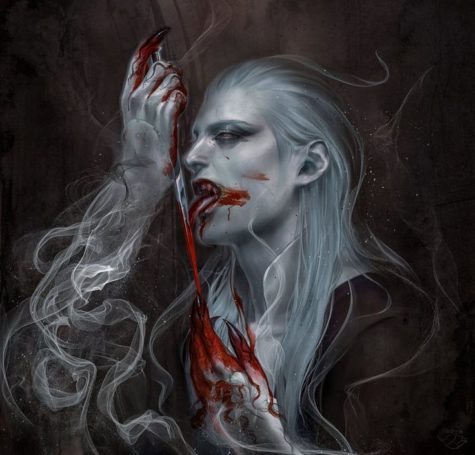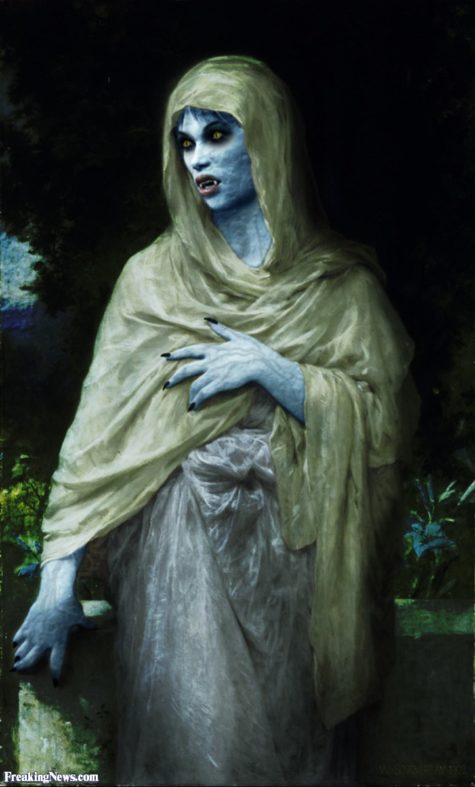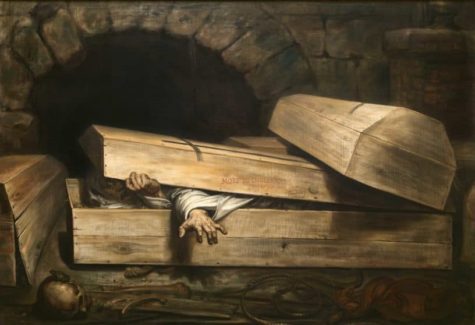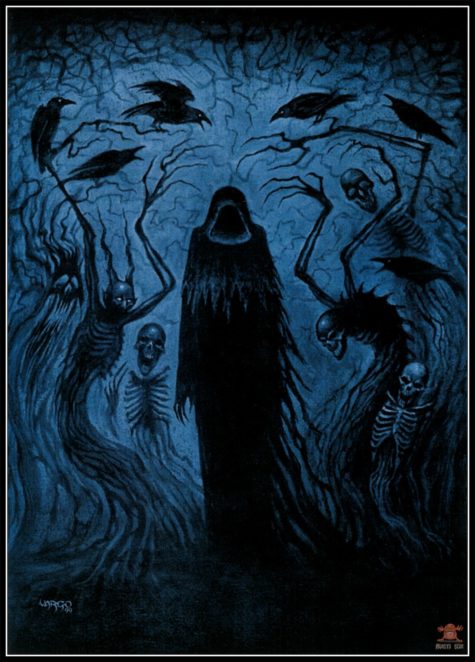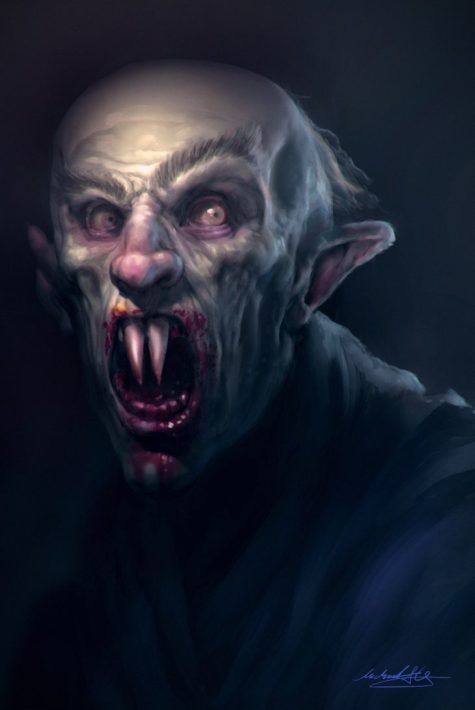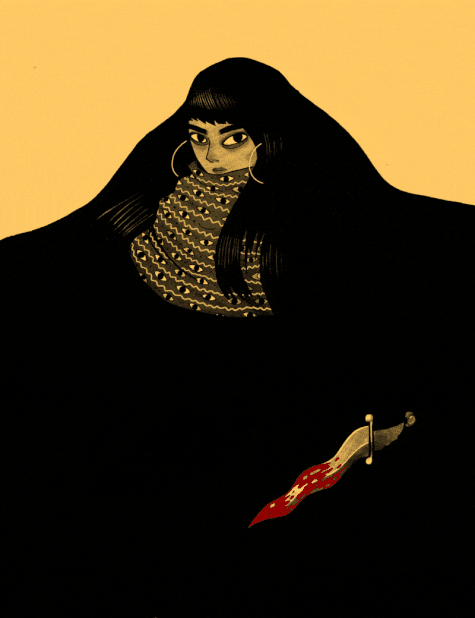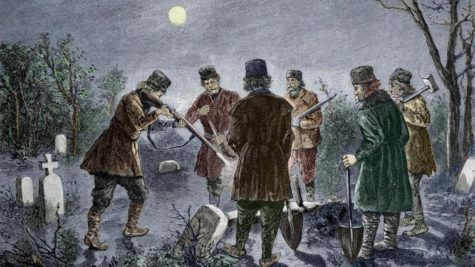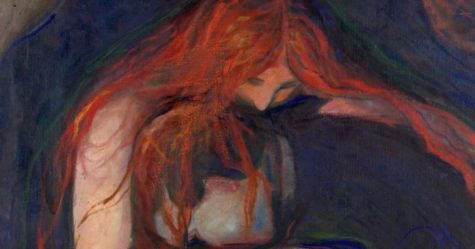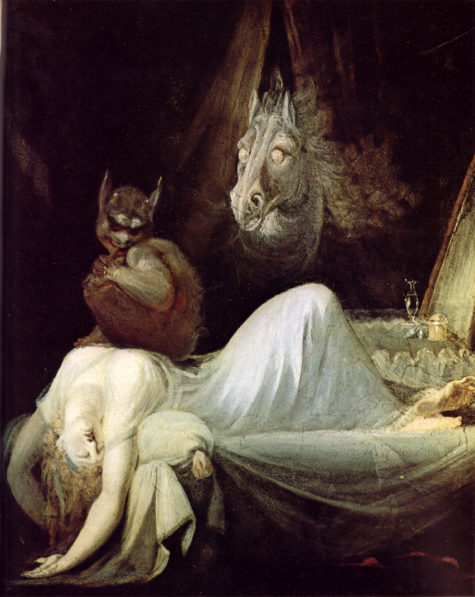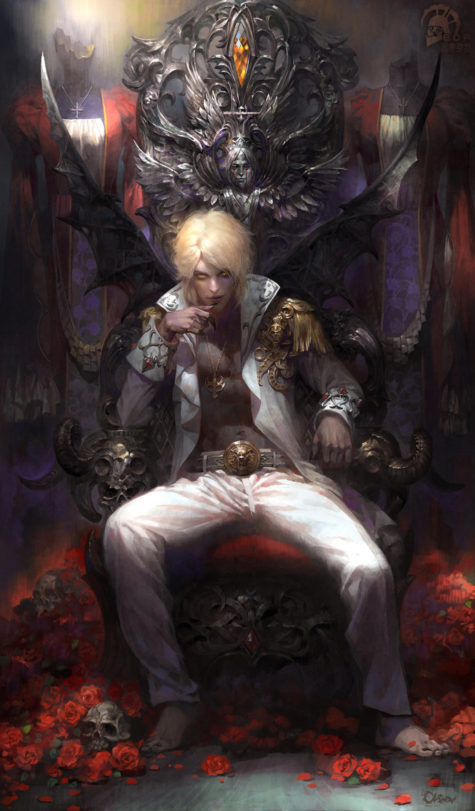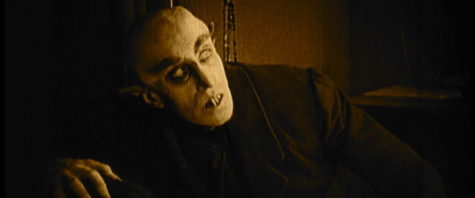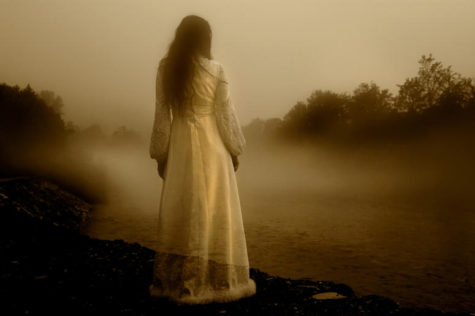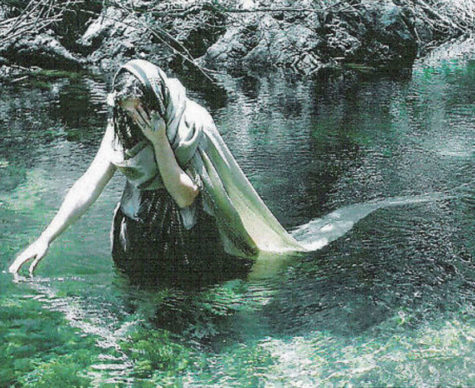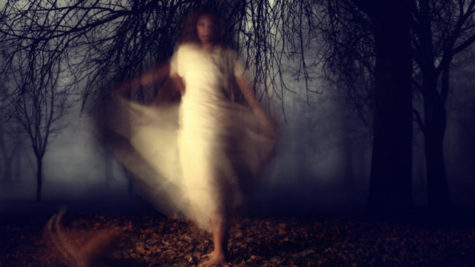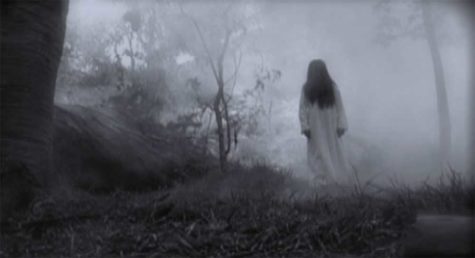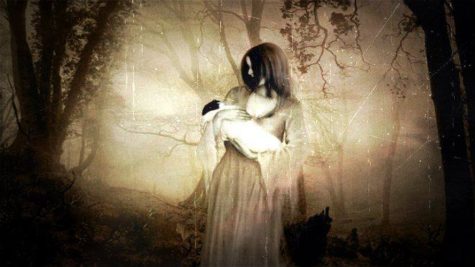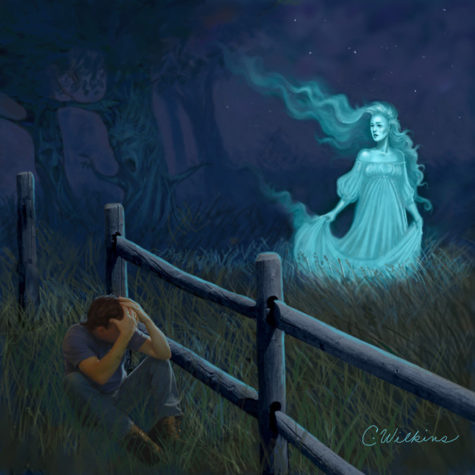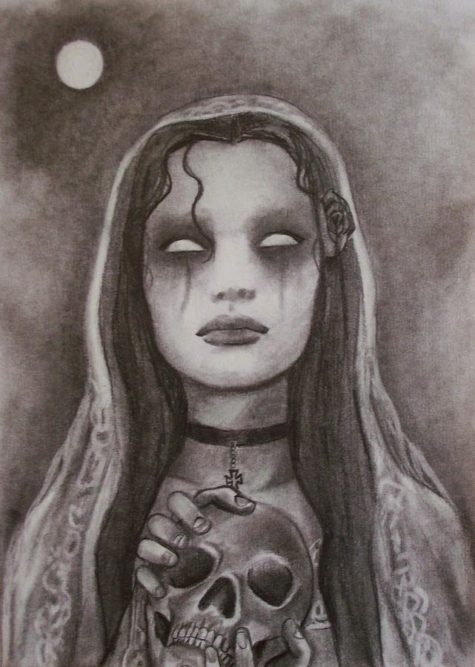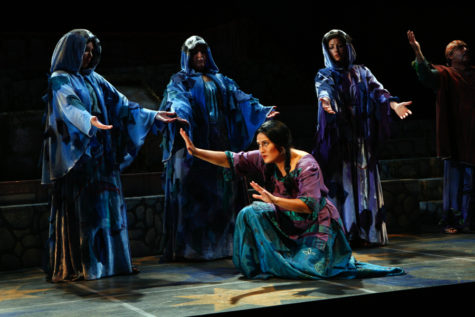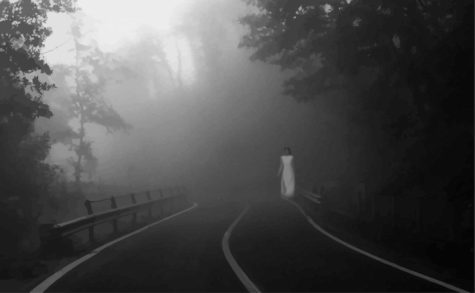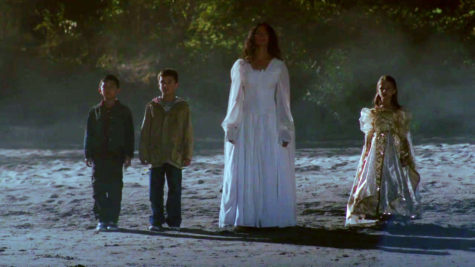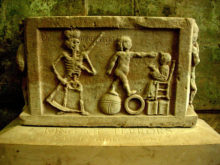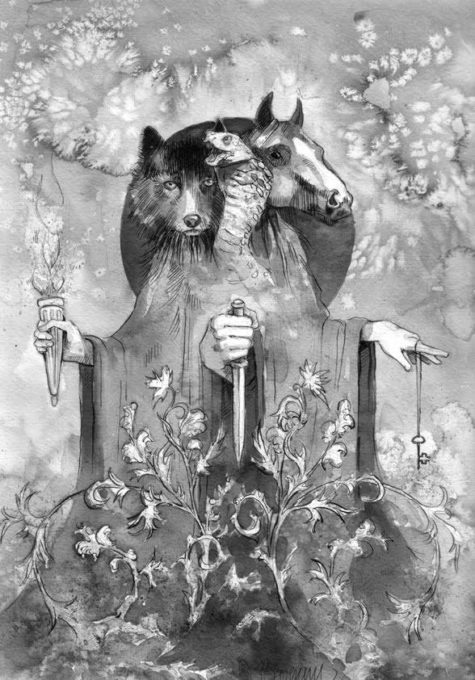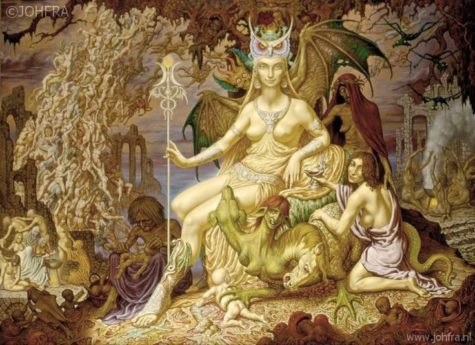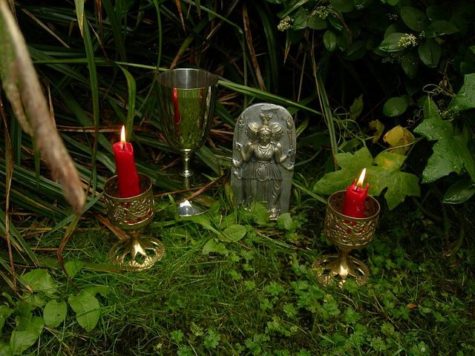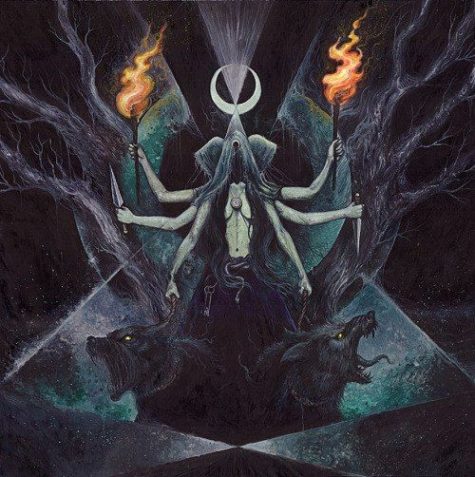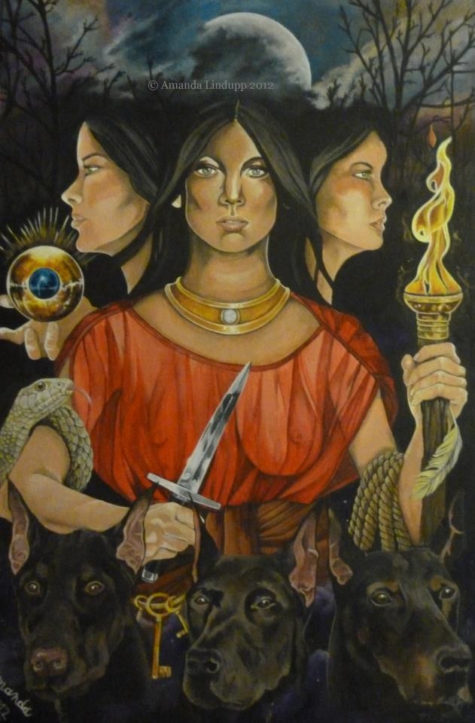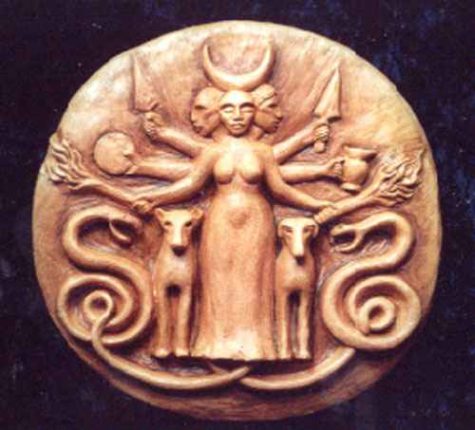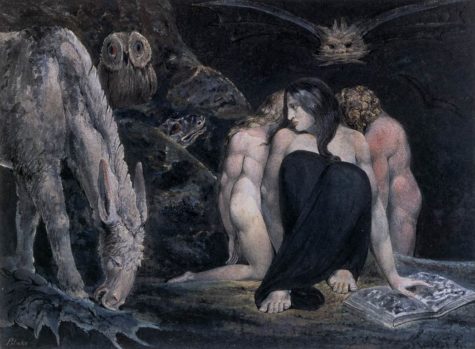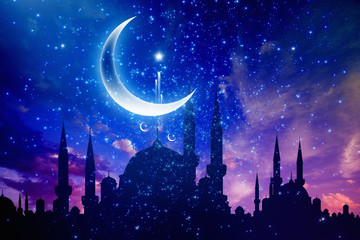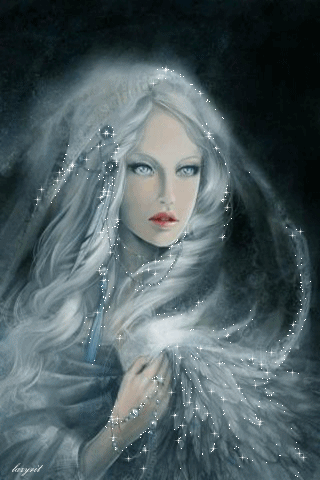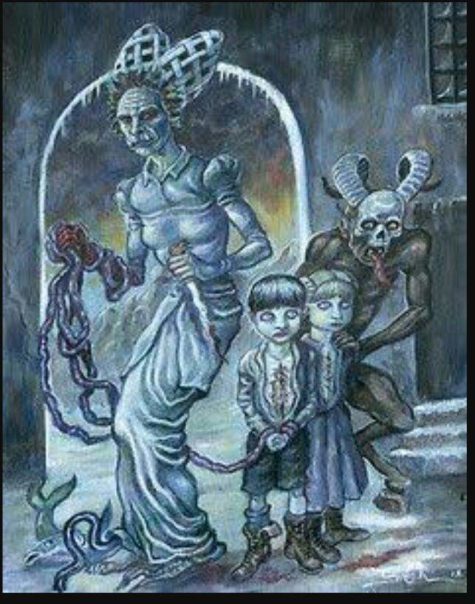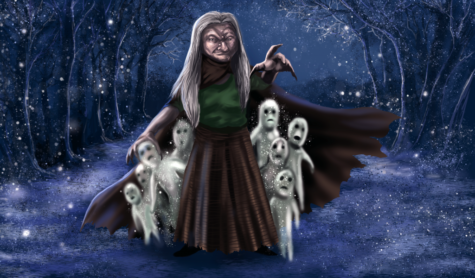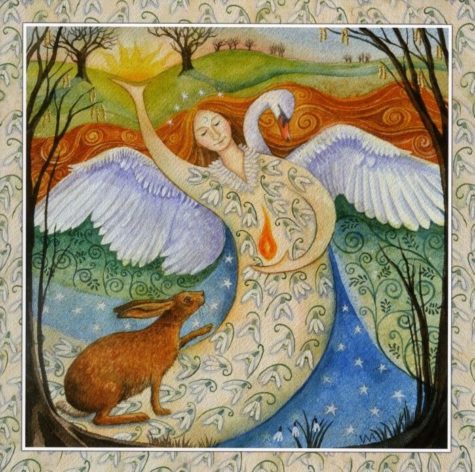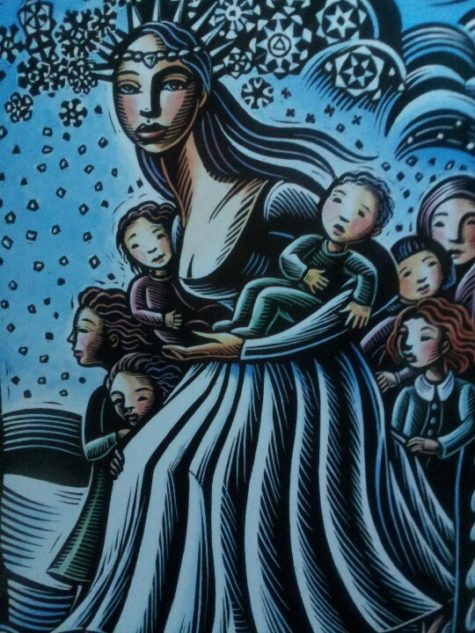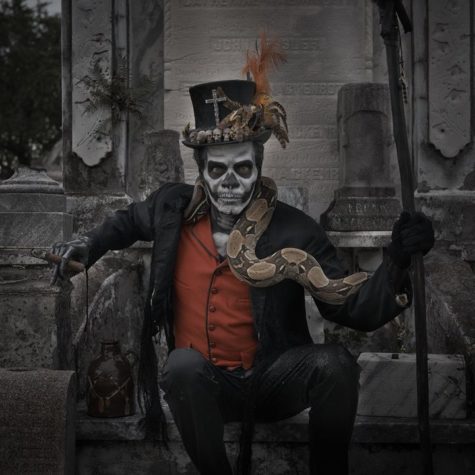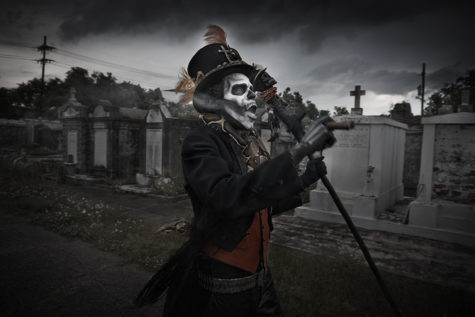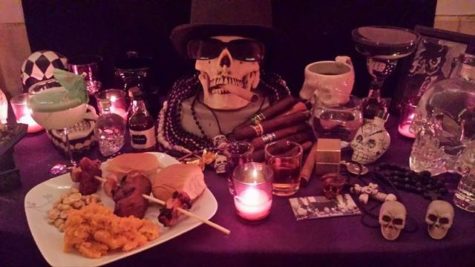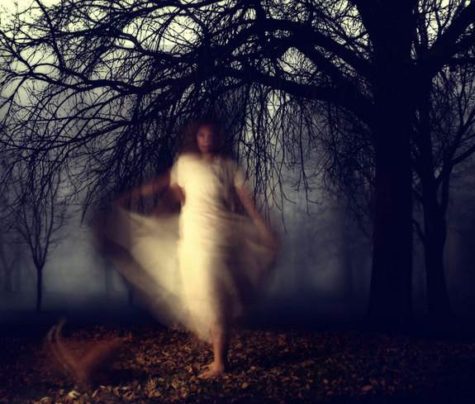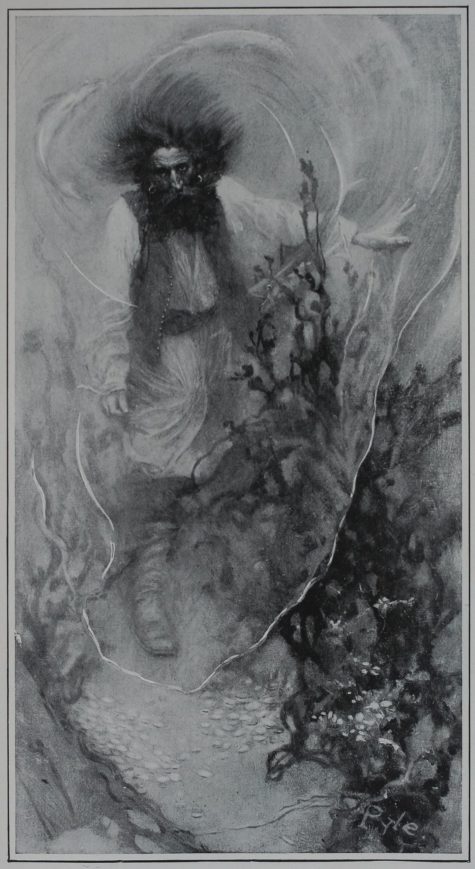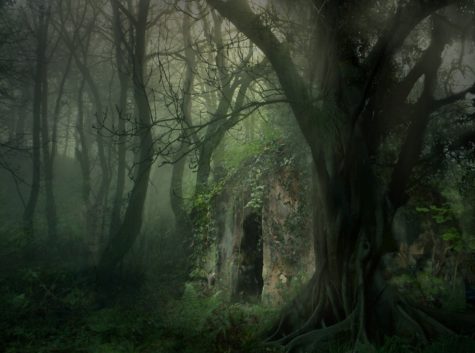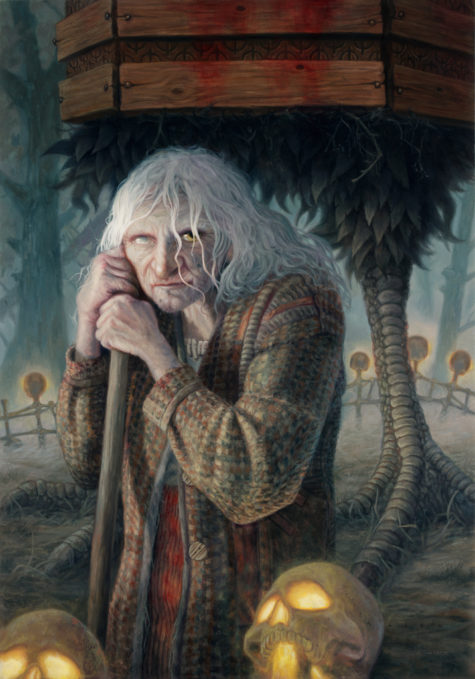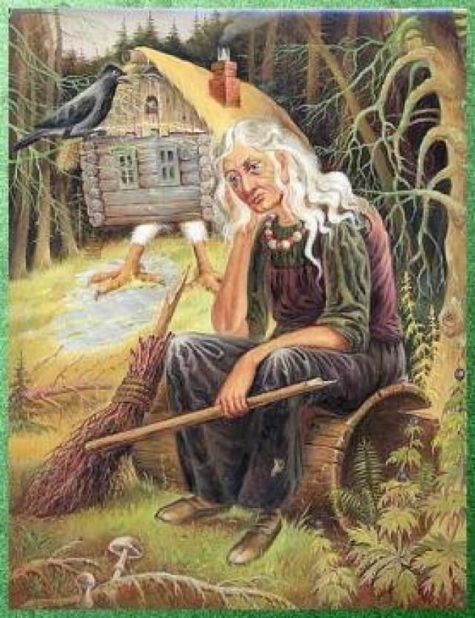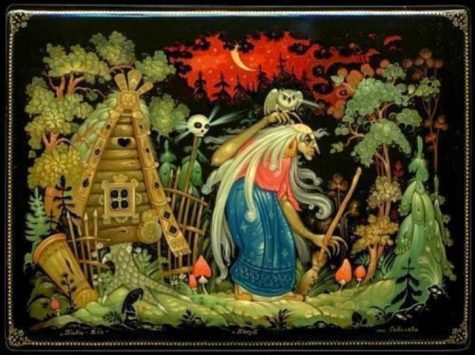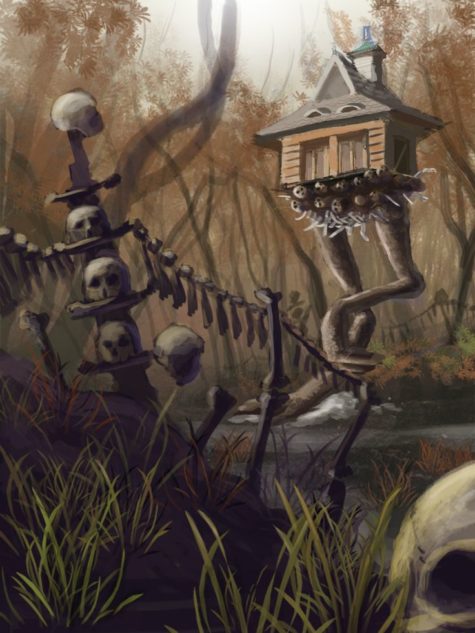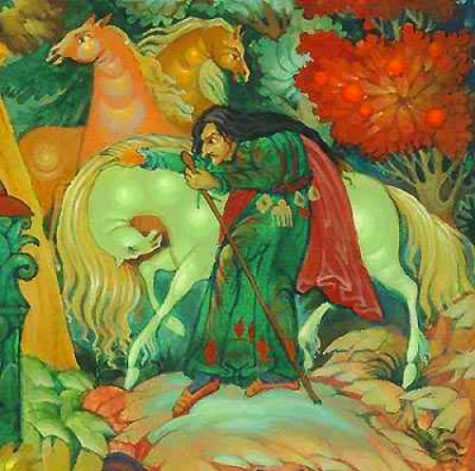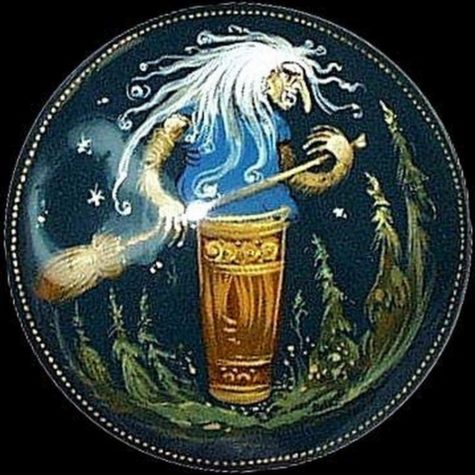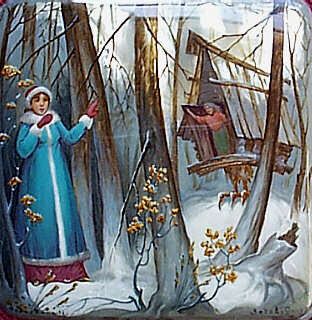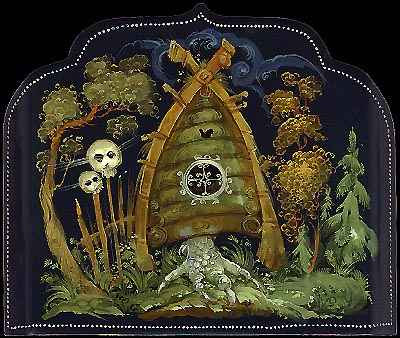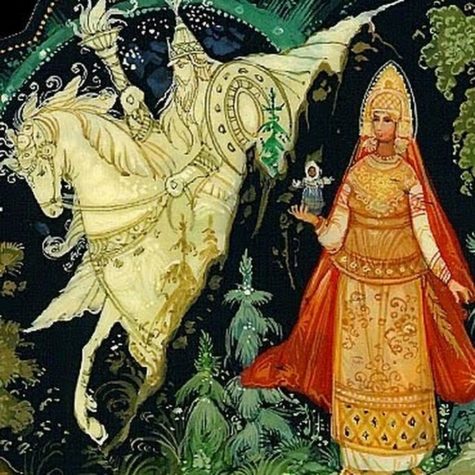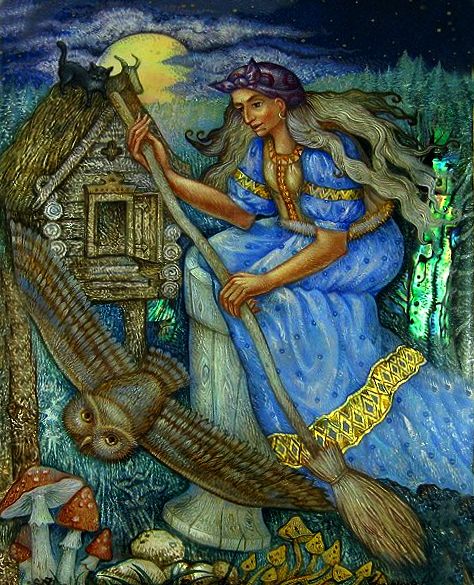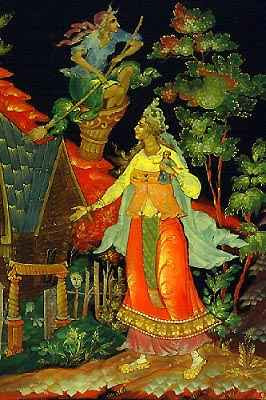Death Spirits
No after-death spirit retains as much fascination for the living as does the vampire. Popularly known as the un-dead, many understand vampires to exist on a plane somewhere between the realms of the living and the dead. Are vampires tortured souls of the dead, compelled to feed upon the living? Or are they souls rewarded with eternal life, able to achieve the alchemist’s ultimate fantasy without spending endless hours shut up in a laboratory?
Who or what exactly are vampires? Interpretations differ; “vampire” is a catch-all word that encompasses many concepts. However, one quality is held in common by all vampires: they suck vitality from others.
The most notorious literary and cinematic vampires, like Bram Stoker’s Dracula, Sheridan Le Fanu’s Carmilla, or the inhabitants of Anne Rice’s novels, are blood-suckers. Some vampires kill their victims by draining them of all their blood immediately. More sensuous vampires prolong the process: it isn’t the loss of blood that ultimately kills the victim. The blood is merely the means for the vampire to drain the victim’s life force away?
Another interpretation suggests that a vampire may not be dead at all but a living sorcerer able to send out his or her shadow soul (and recall it when desired) and that this soul is interpreted by others as a vampire.
The Historical Vampire
The concept of vampirism dates back thousands of years. The ancient Greeks, Hebrews, Egyptians and Babylonians all had legends telling hair-raising tales of demon-like un-dead creatures that lived off of the blood of the living.
Tales of the un-dead consuming the blood or flesh of living beings have been found in nearly every culture around the world for many centuries. Today we know these entities predominantly as vampires, but in ancient times, the term vampire did not exist; blood drinking and similar activities were attributed to demons or spirits who would eat flesh and drink blood; even the devil was considered synonymous with the vampire.
Almost every nation has associated blood drinking with some kind of revenant or demon, from the ghouls of Arabia to the goddess Sekhmet of Egypt. Indeed, some of these legends could have given rise to the European folklore, though they are not strictly considered vampires by historians when using today’s definitions.
Hebrews, ancient Greeks, and Romans had tales of demonic entities and blood-drinking spirits which are considered precursors to modern vampires. Despite the occurrence of vampire-like creatures in these ancient civilizations, the folklore for the entity we know today as the vampire originates almost exclusively from early 18th-century Southeastern Europe, particularly Transylvania as verbal traditions of many ethnic groups of the region were recorded and published. In most cases, vampires are revenants of evil beings, suicide victims, or witches, but can also be created by a malevolent spirit possessing a corpse or by being bitten by a vampire itself. Belief in such legends became so rife that in some areas it caused mass hysteria and even public executions of people believed to be vampires.
In India, tales of vetalas, ghoul-like beings that inhabit corpses, are found in old Sanskrit folklore. Although most vetala legends have been compiled in the Baital Pachisi, a prominent story in the Kathasaritsagara tells of King Vikramāditya and his nightly quests to capture an elusive one. The vetala is described as an undead creature who, like the bat associated with modern-day vampirism, hangs upside down on trees found on cremation grounds and cemeteries. Pishacha, the returned spirits of evil-doers or those who died insane, also bear vampiric attributes.
The Hebrew word “Alukah” (literal translation is “leech”) is synonymous with vampirism or vampires, as is “Motetz Dam” (literally, “blood sucker”). Later vampire traditions appear among diaspora Jews in Central Europe, in particular the medieval interpretation of Lilith. In common with vampires, this version of Lilith was held to be able to transform herself into an animal, usually a cat, and charm her victims into believing that she is benevolent or irresistible. However, she and her daughters usually strangle rather than drain victims, and in the Kabbalah, she retains many attributes found in vampires.
A late 17th- or early 18th-century Kabbalah document was found in one of the Ritman library’s copies of Jean de Pauly’s translation of the Zohar. The text contains two amulets, one for male (lazakhar), the other for female (lanekevah). The invocations on the amulets mention Adam, Eve, and Lilith, Chavah Rishonah and the angels—Sanoy, Sansinoy, Smangeluf, Shmari’el, and Hasdi’el. A few lines in Yiddish are shown as dialog between the prophet Elijah and Lilith, in which she has come with a host of demons to kill the mother, take her newborn and “to drink her blood, suck her bones and eat her flesh”. She informs Elijah that she will lose power if someone uses her secret names, which she reveals at the end.
Other Jewish stories depict vampires in a more traditional way. In “The Kiss of Death”, the daughter of the demon king Ashmodai snatches the breath of a man who has betrayed her, strongly reminiscent of a fatal kiss of a vampire. A rare story found in Sefer Hasidim #1465 tells of an old vampire named Astryiah who uses her hair to drain the blood from her victims. A similar tale from the same book describes staking a witch through the heart to ensure she does not come back from the dead to haunt her enemies.
How does one become a vampire?
Although some spirits are believed to be innately vampiric, transcending rhyme or reason, Different traditions cite different causes, some much crueler than others if one considers the implications.
In actual Transylvanian folklore, illegitimate sons, born outside Church-sanctioned marriages, are doomed to become vampires. Ukranian folklore perceives vampires as the inevitable result of sexual relations between witches and werewolves.
And so we find that people can become vampires not only through a bite, but also if the following situations were to occur:
- According to other legends, those born on Christmas Day are potentially future vampires.
- Were an illegitimate child of parents who were illegitimate.
- Died before baptism.
- Anyone who has eaten the flesh of a sheep killed by a wolf.
- If you were the child of a pregnant woman who was looked upon by a vampire.
- You were given inadequate, improper funeral rites.
- If you are a nun who stepped over an unburied body.
- If you had teeth when you were born.
- Or maybe you were once a werewolf.
- You practiced sorcery before your death.
- A cat jumped on your corpse before you were buried (England and Japan).
- A baby born with teeth.
- A stillborn.
- A bat flying over a corpse (Romania).
- Being excommunicated by the Orthodox Church (Greece).
- Being the seventh son of the seventh son.
- A dead body that has been reflected in a mirror.
- Red heads (Greece).
- People who die by suicide or sudden, violent deaths.
- People who were improperly buried; renouncing the Eastern Orthodox religion.
In folklore, the vampire’s first victim would often be his wife. This is why, in some cultures, when a husband died, the wife would change her appearance, i.e. she would cut her hair and would wear black for the entire period of mourning. These things were done with the intention of deceiving the vampire, should he return.
According to some legends, a vampire may engage in sex with his former wife, which often led to pregnancy. In fact, this belief may have provided a convenient explanation as to why a widow, who was supposed to be celibate, became pregnant. The resulting child was called a gloglave (pl. glog) in Bulgarian or vampirdzii in Turkish. Rather than being ostracized, the child was considered a hero who had powers to slay a vampire.
A completely different idea of how vampires are made can be found in this article by J.L.N. Lewitin.
- Intimate infection from a demon:
There is a contagious quality to being a vampire. One vampire infects, initiates and creates another. Having been attacked by a blood-sucking vampire, according to this school of thought, one either becomes a vampire oneself or dies.
When a vampire, or demon, infects a mortal in such a way that they bind with the physical body of the creature, they can often pry the soul out of control of the body and permanently remove it. The power of the demon fuels the initial removal of the soul, as well as the first few hours of action. After this, most vampires will require the blood or soul of other conscious beings. Over time the demon will become more efficient at extracting the energy from these sources, and will require less. However initially, the need will be quite great.
This method of infection can also be transmitted to other conscious beings through the sharing of blood. In this way the demon within the initial vampire can multiply itself. The power of the second vampire will be slightly less then its makers, however over time it will also increase. There is also some speculation that when the initial vampire is destroyed, if the demon is eradicated with it, that all of the vampires born of that demon will also be destroyed.
These vampires tend to be the most powerful, and possess the strongest attributes. This is because the energy of the demon fuels the initial transformation, and the first few hours of existence. The demon also helps the body to become accustomed to its new existence, and can synthesize the souls or blood of other creatures, making it a useable source of energy. They also make it easier for the body to tap into telekinetic, psychic, and magical powers, as well as the new physical power within its body.
- Infection from a virus:
Some viruses can cause a change in the body which destroys it in such a way that the soul fleas, but the physical brain retains some control over the creature’s actions. Initially such beings will be extremely weak and may be mistaken for dead. However, if they gain a source of energy, and a way to synthesize it into something they can use, they may be able to cobble together a consciousness. Their energy source may be the blood or souls of humans, or might be some other form of magic or chemical energy.
These vampires are marked by weakness, and a lack of consciousness. They are often compared to zombies, with the main difference being that vampires do not seam to degenerate after the initial change, while zombies are in a constant state of decline.
- Vampirism by mental disease:
In rare cases a person’s physical mind can become obsessed with the sensual body to such an extent that it begins to revolt against the creatures inner soul. This is usually a violent struggle, and can be very painful and difficult for the victim.
As the soul is removed the creature begins to require alternate sources of energy to fuel its consciousness. In these scenarios, blood or souls are as likely as any other source to become the fuel, as the creature does not possess the ability to synthesize blood into a useable form. Some cases have been observed where vampires of this type become voracious eaters, others draw their energy from fire, and others use magical means to fuel themselves.
Traditional Vampires
Contrary to popular Hollywood movies, blood-sucking vampires tend to be an aberration. Although they did exist prior to Bram Stoker’s incredibly influential best-selling 1897 novell, Dracula, they were rare and very much a product of Gothic fiction.
Traditional folkloric vampires have comparatively little to do with many literary or movie vampires. Vampire traditions exist throughout virtually all of Eastern and Central Europe. Similar sounding words exist in Slavic, Finno-Ugric, and Romance languages. Variations include:
- Upir
- Wampir
- Vampyr
- Upior
Traditionally speaking, vampires are understood as revenants, living corpses of witches, sorcerers, shamans, and/or magickal practitioners who, for one reason or another, rise from the grave. At their most neutral, they are harmful merely because they are not obeying natural laws; at their worst, they rise with the deliberate intent to cause harm.
Although little or no notion of blood-sucking exists in the original conception, that doesn’t mean a vampire isn’t potentially dangerous. Because vampires may be in a liminal state, between life and death, they require life-energy, which is easiest absorbed from the living. However this life force is more likely to be absorbed via sexual energy or siphoning off “chi” rather than sucking blood. From this perspective, Fox Spirits who sexually drain men to the point of death are considered vampiric.
Identifying Vampires
While most people can name several elements of vampire lore, there are no firmly established characteristics. Some vampires are said to be able to turn into bats or wolves; others can’t. Some are said not to cast a reflection, but others do. Holy water and sunlight are said to repel or kill some vampires, but not others. The one universal characteristic is the draining of a vital bodily fluid, typically blood.
One of the reasons that vampires make such successful literary figures is that they have a rich and varied history and folklore. Writers can play with the “rules” while adding, subtracting or changing them to fit whatever story they have in mind.
Finding a vampire is not always easy: according to one Romanian legend you’ll need a 7-year-old boy and a white horse. The boy should be dressed in white, placed upon the horse, and the pair set loose in a graveyard at midday. Watch the horse wander around, and whichever grave is nearest the horse when it finally stops is a vampire’s grave — or it might just have something edible nearby; take your pick.
Often potential revenants, or vampiric spirits, can be identified at birth, usually by some abnormality, some defect, as when a child is born with teeth. Similarly suspicious are children born with an extra nipple (in Romania, for example); with a lack of cartilage in the nose, or a split lower lip (in Russia). When a child is born with a red caul, or amniotic membrane, covering its head, this was regarded throughout much of Europe as presumptive evidence that it is destined to return from the dead.
Banishing and Destroying Vampires
The best way to deal with vampires, of course, is to prevent them from coming back in the first place. A few centuries ago in Europe this was often accomplished by staking suspected vampires in their graves; the idea was to physically pin the vampire to the earth, and the chest was chosen because it’s the trunk of the body.
This tradition was later reflected in popular fiction depicting wooden stakes as dispatching vampires. There was no particular significance to using wood; according to folklore, vampires — like djinn (genies) and many other magical creatures — fear iron, so an iron bar would be even more effective than a wooden stake.
It was also not unusual for a corpse to be buried face down so it would dig down the wrong way and become lost in the earth.
According to several legends, if someone was bitten by a suspected vampire, he or she should drink the ashes of a burned vampire. To prevent an attack, a person should make bread with the blood of vampire and eat it.
Other traditional methods of killing vampires include decapitation and stuffing the severed head’s mouth with garlic or a brick. In fact, suspected vampire graves have been found with just such signs.
If your local villagers neglected to unearth and stake a suspected vampire and he or she has returned from the grave, there are steps you can take to protect yourself.
The exact method varies around the world, but in some traditions the best way to stop a vampire is to carry a small bag of salt with you. If you are being chased, you need only to spill the salt on the ground behind you, at which point the vampire is obligated to stop and count each and every grain before continuing the pursuit. If you don’t have salt handy, some say that any small granules will do, including birdseed or sand. Salt was often placed above and around doorways for the same reason.
In Macedonian tradition, vampires can be prevented from causing harm by scattering millet seed throughout the cemetery. Any passing vampires are compelled to obsessively pick up every tiny seed, leaving them vulnerable to the banishing rays of the sun.
Traditional vampire repellents and banishers include, bright light or sunlight, garlic, hawthorn branches, rowan trees (later used to make crosses), peppermint, onions, a rooster’s crow, silver bullets, iron bells, bullets created from melted down bell metal, thresholds (unless they’re invited in), mirrors, decapitation with a gravedigger’s spade, salt (associated with preservation and purity), running water, fire, and burying a suspected vampire at a crossroads.
Some traditions hold that vampires cannot enter a home unless formally invited in. This may have been an early form of the modern “stranger danger” warnings to children, a scary reminder against inviting unknown people into the house.
Whether crosses and Church-blessed Holy Water also repels vampires or whether this is merely Christian propaganda is subject to debate. That being said, the following might possibly repel or deter a vampire: churches, crucifixes, eucharist water, holy water, Devotees of Japanese anime will recall that those methods have no effect on Vampire Princess Miyu.
To destroy a vampire, you can:
- Burn it.
- Bury the corpse facedown.
- Drive a wooden stake through its heart.
- Pile stones on the grave.
- Put poppy seeds or wild roses on the grave.
- Boil the head in vinegar.
- Place a coin in the mouth and decapitate with an axe.
- Put a lemon in the mouth.
- Bury at a crossroads.
- Remove the heart and cut it in two.
- Put garlic in the mouth and drive a nail through the temple.
- Cut off the toes and drive a nail through the neck.
- Pour boiling oil on the body and drive a nail through the navel.
More more spells and rituals to banish, deter, repel, and possibly even make peace with vampires can be found at the Book of Shadows and Gypsy Magick and Lore.
Metaphorically Speaking
Vampirism can be understood metaphorically as well as literally: that may not be just any old blood the vampire is draining. Menstrual blood may be perceived as symbolizing women’s mysteries and magick powers. The male vampire depicted preying upon a young woman may be perceived as either attempting to appropriate or annihilate her special power.
Literary and cinematic vampires typically possess a sexual element. To some extent that type of vampire combines the blood-sucker with more ancient incubus (male) and succubus (female). Incubi and succubi are spirits, vampiric creatures who suck and drain sexual vitality, often through sexual intercourse, whether actual physical intercourse or through dream hauntings. Although the visitations may occur in dreams, the severe devitalization is apparent upon awakening.
Philosophy of the Vampire
Vampires are born out of a fundamental change which can occur in the physical bodies of creatures which possess a soul. In most mortals the soul is the fundamental source for action, creating the original impulses which eventually become the person’s acts. It is also a passage through which the creature can gain a small amount of the infinite power underlying the universe, power which is necessary for the functioning of a self conscious being.
A vampire is born when a mortal creature undergoes a change which causes the sensual physical body to revolt against the soul, usually expelling it, and taking control of the creature. The actions of the being are then controlled by either the remaining physical brain, the remnant of the soul, whatever caused the expelling of the soul, or a conglomerate of these forces. It is this emphasis on the physical body to the exclusion of the soul, which causes many vampires to be obsessively sensual and addicted to their own suddenly intense perceptions.
There are many things which can cause a creature to become a vampire. These include certain forms of intimate demonic possession, various viruses, the casting of spells to become a vampire, or mental disease. Each of these causes has its own peculiar nature, and can result in very different outcomes for the victim.
The change into a vampire is almost always accompanied by physical changes in the creature’s body. The most common of these is a removal of the ability to feel pain, and a fundamental change in their perception of the world. These are caused by the sudden lack of soul, which influences the way everything looks and feels.
The immortality of the creature comes due to a perceptual change. The body in complete control of itself does not choose to harm itself with entropy, and so stops doing it. However it is the soul which provides a creature with true wisdom and this form of immortality almost always results in major psychological problems. While immortal, eventually almost all vampires end up committing suicide due to the pressure of their own thoughts.
Changes such as an increase in strength, the ability to fly, psychic and telekinetic powers, and magic abilities are fueled by a power source which accompanies the transformation. As such these abilities are dependent on the amount of energy within the being, and will be increased or decreased by this factor.
Energy is a major problem for vampires, who have to fuel a self conscious existence without the benefit of the soul’s pathway to the infinite power source. If a demon initiates the change, then their inherent power will fuel the initial act. If the change occurs due to a mental problem, or a mental problem caused by a virus, then the remnants of the soul and the body itself will have to fuel the initial change. This often results in vampires of very low consciousness and power.
Later energies have to come from another source, as even the initial power of a demon can not fuel a conscious being for long. This power is often gained through the drinking of the blood or souls of other self conscious creatures. Unfortunately the drinking of a soul, or soul blood, will only give a creature a limited amount of energy, requiring that the vampire repeat this act on a regular basis to survive.
The need for energy can become an obsession in vampires, overwhelming any sense of control and self they may have once had. If the need becomes too great, it can utterly destroy whatever mind remains in the creature, turning them into a zombie.
Some experiments have been done with plasma, as well as nuclear and subatomic energy sources as a way of fueling vampires. This technology is still in its infancy however, and most of the vampiric test subjects claim that these methods are still too weak to effectively sustain them.
Weaknesses Of The Vampire
The greatest weakness vampire’s face is their need for energy, often in the form of blood. Since consuming the blood and souls of conscious beings is generally opposed by the conscious beings themselves, vampires have a constant enemy that they are intrinsically tied to. They can’t live with their prey, but they can’t live without them.
If a vampire finds a way to synthesize enough energy to survive, they will usually develop a second problem. As a creature increases its ability to take energy from subtle existences such as life, they will become more sensitive to the energy in the world around them.
Generally if the vampire becomes good enough at synthesizing energy from blood or souls to survive, they will also become so sensitive to energy that sources such as the sun and fire will be extremely harmful to them. This is why many traditional demon induced vampires, who enjoy instant acclimation to vampirism, also suffer from the inability to go out in daylight. However there can be a convergence point for some vampires where they become so good at synthesizing energy that their power increases faster then their bodies sensitive to light and heat, and they become impervious to them once again.
Sources:
- Live Science
- The Pagan Calendar
- Encyclopedia of Spirits
- Element Encyclopedia of 5000 Spells
- Ancient Thoughts
- Thought Catalogue
The legend of La Llorona (pronounced “LAH yoh ROH nah”), Spanish for the Weeping Woman, has been a part of Hispanic culture in the Southwest since the days of the conquistadors. The tall, thin spirit is said to be blessed with natural beauty and long flowing black hair. Wearing a white gown, she roams the rivers and creeks, wailing into the night and searching for children to drag, screaming to a watery grave.
No one really knows when the legend of La Llorona began or, from where it originated. Though the tales vary from source to source, the one common thread is that she is the spirit is of a doomed mother who drowned her children and now spends eternity searching for them in rivers and lakes.
La Llorona is a legendary figure with various incarnations. She is often presented as a banshee-type: an apparition of a woman dressed in white, often found by lakes or rivers, sometimes at crossroads, who cries into the night for her lost children, whom she has killed.
The infanticide is sometimes carried out with a knife or dagger, but very often the children have been drowned. Her crime is usually committed in a fit of madness after having found out about an unfaithful lover or husband who leaves her to marry a woman of higher status. After realizing what she has done, she usually kills herself.
She is often described as a lost soul, doomed to wander the earth forever.
The legend of La Llorona persists in areas where mountain lions are active. The Audubon Field Guide to North American Mammals notes that the mountain lion’s “blood curdling mating call has been likened to a woman’s scream.
The Legend:
The legend is said that in a rural village there lived a young woman named Maria. Maria came from a poor family but was known around her village for her beauty. One day, an extremely wealthy nobleman traveled through her village. He stopped in his tracks when he saw Maria. Maria was charmed by him and he was charmed by her beauty, so when he proposed to her, she immediately accepted. Maria’s family was thrilled that she was marrying into a wealthy family, but the nobleman’s father was extremely disappointed that his son was marrying into poverty.
Maria and her new husband built a house in the village to be away from his disapproving father. Eventually Maria gave birth to twins: a boy and a girl. Her husband was always traveling, and stopped spending time with his family. When he came home, he only paid attention to the children and Maria knew her husband was falling out of love with her. One day, he left and never returned.
Years later, as Maria and her twins were walking by a river, she saw a familiar carriage with a younger, beautiful woman next to her husband. Maria was so angry and confused that, without thinking, she picked up her two children and threw them into the river, drowning them.
Only after she saw their bodies floating in the river did she realize what she had done and she then jumped into the river, hoping to die with her children. Now she spends eternity looking for her children around that river.
It is said that if you hear her crying, you are to run the opposite way. If you hear her cries, they could bring misfortune or even death. Many parents in Mexico and Guatemala use this story to scare their children from staying out too late.
At the gates of heaven, she was challenged over the whereabouts of her children, and not permitted to enter the afterlife until she found them. Llorona is forced to wander the Earth for all eternity, searching in vain for her drowned offspring. She constantly weeps, hence her name “La Llorona.” She is caught between the living world and the spirit world.
Variations of the Story:
In some versions of the tale, La Llorona kidnaps wandering children who resemble her missing children, asks them for forgiveness, then kills them to take the place of her own. People who claim to have seen her say she appears at night or in the late evening by rivers or lakes.
Some believe those who hear the wails of La Llorona are marked for death but those who escape in time are not, as in the Gaelic banshee legend. Amongst her wails she is noted as crying “¡Ay mis hijos!” which translates to “Oh my children!” In the Guatemalan version of the legend, it is said that when her wails sounds near she is actually far and when she sounds distant- she is actually very near.
It should be noted that the folklore will vary dependent on the location as it is not specific to any one region and is known throughout numerous Latin American countries.
La Llorona is also sometimes identified with La Malinche, the Nahua woman who served as Cortés’ interpreter and mistress who bore his children and who some say was betrayed by the Spanish conquistadors. In one folk story of La Malinche, she became Hernán Cortés’ mistress and bore him a child, only to be abandoned so that he could marry a Spanish lady (although no evidence exists that La Malinche killed her children).
Aztec pride drove La Malinche to acts of vengeance. In this context, the tale compares the Spanish discovery of the New World and the demise of indigenous culture after the conquest with La Llorona’s loss.
Similar Stories:
The Chumash of Southern California have their own connection to La Llorona. Chumash mythology mentions La Llorona when explaining nunašɨš (creatures of the other world) called the “maxulaw” or “mamismis.” Mythology says the Chumash believe in both the nunašɨš and La Llorona and specifically hear the maxulaw cry up in the trees. The maxulaw cry is considered an omen of death. The Maxulaw is described as looking like a cat with skin of rawhide leather.
Outside the Americas, La Llorona bears a resemblance to the ancient Greek tale of the demonic demigodess Lamia. Hera, Zeus’ wife, learned of his affair with Lamia and, out of anger, killed all the children Lamia had with Zeus. Out of jealousy over the loss of her own children, Lamia steals other women’s children. In Greek mythology, Medea killed the two children fathered by Jason (one of the Argonauts) after he left her for another woman.
Author Ben Radford’s investigation into the legend of La Llorona, published in Mysterious New Mexico, traced elements of the story back to a German folktale dating from 1486.
Modern Stories:
A Mexican woman, Juana Léija, attempted to kill her seven children by throwing them into the Buffalo Bayou in Houston, Texas in 1986. A victim of domestic violence, she was apparently trying to end her suffering and that of her children, two of whom died. During an interview Léija declared that she was La Llorona.
This folk story has been represented artistically in various guises: in film, animation, art, poetry, theatre and in literature aimed at both adults and children alike. The legend is deeply ingrained in Mexican culture and among the Chicano Mexican population of the United States.
When Patricio Lugan was a boy, he and his family saw her on a creek between Mora and Guadalupita, New Mexico. As the family was sitting outside talking, they saw a tall, thin woman walking along the creek. She then seemed to float over the water, started up the hill, and vanished. However, just moments later she reappeared much closer to them and then disappeared again. The family looked for footprints and finding none, had no doubt that the woman they had seen was La Llorona.
She has been seen along many rivers across the entire Southwest and the legend has become part of Hispanic culture everywhere. Part of the legend is that those who do not treat their families well will see her and she will teach them a lesson.
Another story involved a man by the name of Epifanio Garcia, who was an outspoken boy who often argued with his mother and his father. After a heated argument, Epifanio, along with his brothers, Carlos and Augustine decided to leave their ranch in Ojo de La Vaca to head toward the Villa Real de Santa Fe. However, when they were along their way, they were visited by a tall woman wearing a black tapelo and a black net over her face.
Two of the boys were riding in the front of the wagon when the spirit appeared on the seat between them. She was silent and continued to sit there until Epifanio finally turned the horses around and headed back home, at which time she said “I will visit you again someday when you argue with your mother.”
In Santa Fe, New Mexico, the tall wailing spirit has been seen repeatedly in the PERA Building (Public Employees Retirement Association), which is built on land that was once an old Spanish-Indian graveyard, and is near the Santa Fe River. Many people who have been employed there tell of hearing cries resounding through the halls and feeling unseen hands pushing them while on the stairways.
My story of La Llorona takes place in Mexico. When I was eight years old when my abuelita (grandma) told me to go to the store to buy soda. This was during the evening as we were getting ready to eat supper. My brother and I left for the store and along the way we heard wailing but we didn’t pay much attention to it. However, as we continued on we saw a young woman walking toward us.
All of a sudden my little brother started to cry and the woman ran toward him, acting as if she was going to get him. When we saw that she was floating instead of walking we began to run back to our house and told our grandmother and mom what had happened. We just locked the door and started to pray to God to help us and make La Llorona go away.
Cries in the Night
When I was 12 years old (1991), my parents separated and my mother moved me and my brother to Monterrey Mexico. In the winter all three of us would sleep in the same room because there was no central heating — only electric heaters. There were two beds for my mother and brother. I slept on the floor in a sleeping bag, next to my mother’s bed.
One night around 2:30 in the morning, I woke up because I had been dreaming about my great grandma. She kept calling my name — three times to be exact. Just a few minutes later I heard the scariest screams coming from down the street. It was horrible!!! The cries continued, each time coming closer. I was so horrified that I could not even wake my mother who was laying right next to me! I was so scared, I did not even blink. It was the most evil cry I have ever heard!
Finally, it passed my house and slowly faded away! The next day I told my mother. You know, I didn’t believe in stuff like this, especially not La Llorona. After that night, I do.
A Kansas Tale
Recently while working as a copy editor for a newspaper, I came across a wire story about the La Llorona. That brought back memories of what happened to me while I was a student at Kansas State University in the early 1980s in Manhattan, Kansas, and led me to your Web site where I read more about the legend.
One evening I went to a mobile home that I seem to remember being near a creek or river to visit a couple of my friends who also were attending K-State. As I walked into the door, I found them sitting on the sofa looking somewhat freaked out. They explained that just moments earlier one of the bar stools was spinning and hopping around. As they were Mexican-Americans, they wondered whether the La Llorona had anything to do with that incident. They explained the legend to me as I had never heard about it before.
They would invite me to stay the night in a spare bedroom, which I did. Later in the night a woman appeared to me, laying next to me in bed, and asked if I would know where her children were. It seemed that, while I may have been dreaming, I was half-awake.
Then I fully awoke and looked up toward the doorway just in time to see a dark figure seemingly looking at me and then quickly ducking back out the doorway. Right then that left me too scared to go check and see if that was one of my friends checking in on me, perhaps to see why I was talking in my sleep or something. I went back to sleep and waited until the morning to ask them if either one of them looked into my room during the night. Neither one did.
So to this day I do not know whether I really did experience a supernatural visit or if my dream and mind played tricks on me.
Possible Origins of the Story
The origins of the legend are uncertain, but it has been presented as having pre-Hispanic roots. La Llorona is thought to be one of ten omens foretelling the Conquest of Mexico and has also been linked to Aztec goddesses. In the Florentine Codex, an encyclopedic work on the Nahua peoples of Mexico completed during the 16th century by the Franciscan friar Bernardino de Sahagún, we find two Aztec goddesses who could be linked to La Llorona.
The first is Ciuacoatl (Snake-woman), described as ‘a savage beast and an evil omen’ who ‘appeared in white’ and who would walk at night ‘weeping and wailing’. She is also described as an ‘omen of war’. This goddess could also be linked to the sixth of ten omens that are recorded in the codex as having foretold the Conquest: the voice of a woman heard wailing at night, crying about the fate of her children.
A later codex by a Dominican friar, Diego Durán, details the origin myths of the Aztec gods and discusses a goddess, Coatlicue, who is often linked to or thought to be the same as Ciuacoatl. Coatlicue (she of the snaky skirt) was the mother of Huitzilopochtli, the Aztec god of war.
Durán describes her as ‘the ugliest and dirtiest that one could possibly imagine. Her face was so black and covered with filth that she looked like something straight out of Hell’. She waits for her son to return to her from war and weeps and mourns for him while he is gone. Durán also provides detail of some strange occurrences ahead of the Conquest that were purported to have troubled Moctezuma. Among these is a ‘woman who roams the streets weeping and moaning’.
According to the Florentine Codex, Chalchiuhtlicue (the Jade-skirted one) was goddess of the waters and the elder sister of the rain god, Tlaloc. Sahagún describes her as one who was ‘feared’ and ‘caused terror’. She was said to drown people and overturn boats. Ceremonies in honor of the rain gods, including Chalchiuhtlicue, involved the sacrifice of children.
These sacrificial victims were bought from their mothers and the more the children cried, the more successful the sacrifice was thought to have been.
There are many similar European and Old World motifs that she could also be linked to: the ‘White Woman’ of the Germanic and Slavic tradition, the Lorelei and, of course, the banshee. The trope of the barbarian girl who kills her children after being betrayed by her lover and discarded for a woman of higher status or more ‘appropriate’ race also has roots in the Greek tradition, in the legend of Medea and Jason.
It is strange that such a pervasive myth could have such different features, but still be known by the same name. Indeed, the variations in the folk story seem to be geographical, with different regions having their own slightly different versions of the wailing woman.
In addition, the legend has changed over time, seemingly to reflect the socio-political climate. Just as a source will often tell us more about the author than the subject, we can glean a lot about the story-tellers’ points of view when examining the development of this particular legend. It is not until the late 19th and early 20th centuries that the folk story can be found in print. However, when we look at them, far from finding an official version, we can clearly see that many elements of the La Llorona story change over time.
La Llorona ~ The Play
La Llorona, a 1917 play by Francisco C. Neve is set during the reign of Philip II (1556-98). The protagonist is Luisa. She has a son with her lover, Ramiro, the son of Cortés, who is of much higher social status. Though they have been together for six years, Ramiro is due to marry the very wealthy daughter of a judge. Luisa is unaware of this and Ramiro believes that he can continue his relationship with her, if he marries in secret.
Luisa is told of Ramiro’s impending wedding by a rival suitor and she is driven mad, not only by Ramiro’s infidelity and his decision to marry someone else for honor and status, but by his desire to take their son away from her. When he comes for their child after she breaks up their wedding, Luisa eventually tells him that he can have his son’s life and kills him with a dagger, offering Ramiro his body in a fit of delirium, saying that she killed him after Ramiro had killed her soul.
Luisa is hanged for her crime in a public execution during which she is vilified as a witch. Ramiro is presented as very remorseful and dies of sorrow and grief when La Llorona appears to haunt him.
The play satirizes the class system to an extent and especially masculine ideas of honor. Ramiro’s mistress and son are an open secret among court society and whispers of gossip surrounding his love life are a prominent theme at his sham wedding. He does not garner respect from his peers and courtly society in New Spain is presented as a place of back-stabbing and chaos.
La Llorona in Popular Culture:
La Llorona appeared as the first antagonist in the 2005 pilot episode of the TV series Supernatural. Sarah Shahi portrayed Constance Welch, The Woman in White who, after discovering her husband’s infidelity took the lives of her two children by drowning them in a bathtub at home and soon after, took her own by jumping off a bridge into a river.
Her ghost was known to haunt the Centennial Highway, hitchhiking unknowing motorists, mostly men, and killing those whom she deemed unfaithful. Sam Winchester destroyed her ghost by crashing his car into the house where she used to live. Finally facing the ghosts of her children, The Woman in White was destroyed by her own guilt from killing them.
La Llorona briefly appears in the 1973 Mexican film Leyendas macabras de la colonia. La Llorona is mentioned and appears in several episodes of “El Chavo del Ocho” and “El Chapulín Colorado”, both comic series written by Roberto Gómez Bolaños, aka Chespirito.
La Llorona appears as the main antagonist of the Mexican animated film La Leyenda de la Llorona. Here, La Llorona is portrayed as a more sympathetic character, with her children’s deaths coming as an accident rather than at her own hands.
In 1995, Mexican playwright Josefina Lopez wrote “Unconquered Spirits”, which uses the myth of La Llorona as a plot device. The play has two time periods, with Act One taking place in 16th Century Mexico after Spain occupied it. Here, Lopez takes inspiration from the “La Malinche” variation, with the heroine represented as a young Aztec girl who is brutally raped by a Spanish Friar. She gives birth to twin boys as a result, and drowns them in the river out of protection rather than spite.
Act Two takes place in 1938 amidst the San Antonio Pecan Sheller’s Strike. A widowed mother who works at the Pecan factory has an abortion after being raped by her white supervisor, resulting in a visit from La Llorona to give her the strength to fight back against her attacker. The play is well noted for its sympathetic portrayal of La Llorona as a victim of oppression.
La Llorona appeared as the “monster of the week” in the NBC TV series Grimm, in the ninth episode of the second season which first aired on October 2012. In this storyline, she is a ghost-like creature (her exact origin and nature is undefined) who appears in different cities at yearly intervals around Halloween, always luring three children to a point where three rivers meet, attempting to ‘sacrifice’ these children to regain her own. In the episode, they manage to save her latest victims, although La Llorana simply vanishes into the water.
In Nancy Farmer’s 2002 science fiction novel, The House of the Scorpion, and its 2013 sequel book, The Lord of Opium, the main character, Matt, makes several references to La Llorona, often when retelling the story to other main characters or during self-reflection.
La Llorona is mentioned in the 2003 film Chasing Papi starring Sofía Vergara, Roselyn Sánchez, Jaci Velasquez, and Eduardo Verástegui. Her screams can be heard when Thomas (Eduardo) is under stress or confronted by the three women in his life. La Llorona’s image is shown a few times in the film too.
- The song “She Turned Into Llorona” appears on the 2003 Manic Hispanic album Mijo Goes to Jr. College.
- The 2006 Mexican horror film Kilometer 31 is inspired by the legend of La Llorona, and the main evil entity in the film is based on her and her story,
La Llorona has also been the theme character of several of Universal Studios’s haunted houses during their annual Halloween event, Halloween Horror Nights (Both Hollywood and Orlando locations).
The story of La Llorona has been turned into a short comic book story by Love and Rockets writer/artist Gilbert Hernandez. La Llorona is also one of the various names used by Hopey and Terry’s punk band in Jaime Hernandez’s Mechanics series.
- La Llorana appeared as a ghost in Batwoman #1 (Volume 2) in November 2011.
- La Llorona appears in Josh Walker’s 2014 novel, Luke Coles and the Flower of Chiloe where the Llorona is the mark of one of Luke’s hunts.
- La Llorona also is a short film which was released in 2015.
- La Llorona is the basis for the “monster of the week” in the fifth episode of the second season of Sleepy Hollow entitled “The Weeping Lady”.
Morgana, a playable character in League of Legends, has a skin called “Ghost Bride” (named “La Llorona” in Spanish). She has different voice over lines in the Latin American regions (North and South) and the skin was released as a way to celebrate the launch of Latin American servers.
- The sixteenth track of the Frida Soundtrack is titled “La Llorona”. It is sung by Chavela Vargas.
- The twelfth track from the self-titled album by the Latina punk band FEA is “La Llorona”, and is based on the legend, with the cry/lyrics in the chorus of “mis hijos, mis hijos!”.
The song “La Llorona” is featured in the 2017 Disney-Pixar film Coco, sung by Imelda Rivera (voiced by Alanna Ubach) during the sunrise concert as she attempts to evade Ernesto de la Cruz who sings the song in duet with her (voiced by Benjamin Bratt with his singing voice provided by Marco Antonio Solís).
In the 2000 Sci-Fi series, The Invisible Man, La Llorona is the code-name for a Chrysalis’ agent modified to be able to consume large amounts of water and spew them out forcibly and at-will.
- The debut studio album of Lhasa de Sela is called “La Llorona”.
- On March 7, 2018 Primero Soy Mexicana by Angela Aguilar was released on which “La Llorona” is the 7th track.
James Wan and Gary Dauberman are producing a film about La Llorona, titled The Curse of La Llorona. It is scheduled to be released on April 19, 2019 by New Line Cinema and Warner Bros. Pictures. The film will be directed by Michael Chaves and star Linda Cardellini, Raymond Cruz, and Patricia Velasquez.
Sources:
The King of Terrors is among those spirits classified as Holy Death. He is closely related to the Grim Reaper. The King of Terrors is a skeleton bearing weapons. He may be crowned. He is a psychopomp but a fierce, scary one. His name says it all. He does not arrive bearing comfort or platitudes.
The name, King of Terrors, derives from the Book of Job 18:14:
“He is torn from the security of his tent
and marched before the King of Terrors.
Thus the King of Terrors is traditionally depicted driving dead souls before him. His image is carved onto tombstones and as ornamental motifs on medieval churches, most famously at Scotland’s Rosslyn Chapel.
Source: The Encyclopedia of Spirits
Hekate is an exceptionally powerful spirit. She holds dominion over life, death, regeneration, and magic. She rules wisdom, choices, expiation, victory, vengeance, and travel. Hekate guards the frontier between life and death. She is an intermediary between the spirit world and that of humans. She is the witness to all crimes, especially those against women and children.
Hekate (Hecate) is Queen of the Night, the Spirit World, and Witchcraft. Her epithets include:
- She Who Works Her Will
- The Most Lovely One
- Influence From Afar
- Three Headed Hound of the Moon
- The One Before The Gate
- Light Bringer
Although today most associated with Greek mythology, her name, meaning “influence from afar,” acknowledges her foreign origins.
Generally believed to have first emerged in what is now Turkey, she was not an obscure goddess. Hekate was at one time chief deity of Caria, now western Turkey, and was eventually widely worshiped throughout Europe, Western Asia, and Egypt. Records of formal worship date from eighth century BC to the fourth century AD, although as magic fell from grace she became an increasingly disreputable spirit. All Hekate’s myths clearly identify her as a witch and matron of magical arts.
Hekate is renowned for her expertise with plants and her knowledge of their magickal and healing powers. A famed magickal garden was attached to her temple in Colchis on the Black Sea, now in modern Georgia. Some scholars suggest that an ancient Greek women’s guild, under the divine matronage of Hekate, once had responsibility for gathering and storing visionary, hallucinatory and poisonous plants. The same work in Greek indicates “pharmacist,” “poisoner,” and “witch.”
Petitioning Hekate
Hekate is a goddess of life, death, regeneration and magick. She rules wisdom, choices, expiation, victory, vengeance, and travel. She is witness to every crime.
- She is invoked for justice, especially for sexual crimes against women and girls.
- Hekate is invoked when justice is not forthcoming from other channels.
- Hekate has the power to grant or deny any mortal’s wish.
- She may be invoked for protection for dogs and from dogs.
- Hekate is petitioned for fertility, especially for female children.
- She brings victory in battle.
- Hekate may be invoked for healing, especially if medical solutions have failed.
- She may be petitioned for swift, painless death.
- Hekate can banish ghosts – or produce a ghost infestation.
Hekate typically responds to petitions via visions and dreams. If lost at a crossroads, literal or metaphoric, invoke her name and then pay attention to signs from her. She can be a shadowy, oblique goddess: her response may be subtle. Look for her animals: snakes, dragons, cats, and especially dogs.
- Favored people
Midwives, witches, healers, herbalists, dog lovers and rescuers. She is the matron of women in general and protects those who ride horses.
A Living Altar
Hecate is most famous today as a Dark Moon Spirit and Queen of Witches. Those are but two aspects of this multifaceted deity. Hecate was once the chief deity of the Carian nation, now in Western Turkey. She is matron of the city of Istanbul. She has dominion over life and death and makes the journey in between, indicating her power as a healing deity. Hecate is matron of midwives and herbalists.
Her priestesses (the most famous was Medea) were trained herbalists. Those in need of healing or solace journeyed to the gardens attached to Hecate’s shrine in Colchis on the Black Sea, home of the Golden Fleece pilfered by the Argonauts.
Hecate’s assistance may also be accessed by building a living altar in her honor. Plant a garden outdoors or create a living altar inside with potted plants. Add some or all of the following:
- Dog roses,
- Garlic,
- Lavender,
- Mandrake,
- Queen of the Night,
- Roses,
- Thorn apple,
- Tuberoses.
Hecate’s trees include:
- Black poplar
- Date palm
- Pomegranate
- Willow
- Yew
Place votive images of Hecate, together with her favorite creatures – dogs, dragons, and snakes – in the garden. To petition Hecate directly or to receive spontaneous magical inspiration regarding your healing needs, sit in or beside your living altar in the dark.
To Summon Hekate
Hecate, Queen of Witches, maintains office hours only at night: formal petitions and invitations must be offered after dark. A particularly ancient spirit, the only source of illumination she favors is fire.
Summon Hecate at night by a three-way crossroads. Ideally, light your way with a mullein torch. Offer her garlic, lavender, and honey. If you have a dog, bring it with you. Keep an eye on the dog; it’s likely to perceive Hecate before you do.
Why would you wish to contact Hecate?
Because she can teach you to do anything with magic. Because she can grant you enhanced psychic powers, fertility, romance, protection, freedom from illness, and magical restitution for any crime committed against you.
Hekate has been with us for at least three thousand years.
She was a liminal goddess who was present at all the boundaries and transitional moments in life. She was also an ‘evil-averting’ protector and guide. Her triple form emphasized her power over the three realms, these being the heavens, sea, and earth. Her primal nature was seen in the many animal heads she was depicted with, each emphasising different qualities of her manifold character.
Some of her well known titles include:
- Chthonia – earthy one
- Dadouchos – torch bearer
- Enodia – of the ways
- Kleidouchos – key bearer
- Kourotrophos – child’s nurse
- Phosphorus – light bearer
- Propolos – companion
- Propylaia – before the gate
- Soteira – savior
- Triformis – three bodied
- Trioditis – of the three ways
To enhance your ability to summon Hecate, try this:
Dry dandelion roots, then slice and pierce them to create beads, forming a ritual necklace to wear when calling Hecate. Call – or think – Hecate’s name as you pierce, string, and knot each bead. For best results, string the necklace at night by firelight.
Another way to enhance your relationship with the Queen of the Night is to practice the Silence of the Night Meditation. It’s a very simple yet profoundly powerful meditation, especially when practiced for an extended period of time.
Manifestations
Hekate has been known to assume the shape of a black cat, a bear, a pig or a hen but most typically manifests as a mature woman or black dog. She has a particularly strong bond with dogs. Even when manifesting in human form, Hekate is usually accompanied by hounds. Somehow there will be a canine reference. When manifesting as a woman alone, Hekate often circles in the manner of a dog.
Artistic renderings of Hekate usually attempt to capture her spiritual essence. She may be depicted with three bodies, each facing a different direction. One hand holds the knife that is the midwife’s tool, another holds a torch to illuminate the darkness, the last bears a serpent representing medical and magical wisdom. Sometimes Hekate is depicted with a woman’s body but three animal heads – those of a dog, a horse, and a lion.
Hekate, Queen Witch, is a shape-shifter supreme. While her usual manifestations are as a black dog or mature woman, she may manifest as a haggard, decrepit crone or a sexy, elegant, seductive woman. She even has an occasional mermaid manifestation. She may wear snakes in her hair. Every now and then, she appears as a black cat, snake, or dragon.
Sacred to Hekate
Hekate’s sacred time is black night. All her festivities and ceremonies are held after dark, the only acceptable illumination is candles or torches. She only accepts offerings and petitions at night. Hekate is identified with the Dark Moon, the time of her optimum power.
The last day of each month is dedicated to Hekate. She also shared a festival with Diana on August 13th in Italy. Modern Wiccans, for whom Hekate is an important deity, celebrate November 16th as Hecate Night of the Crossroads.
- Animals: Black ewe lambs, Boar, Bull, Cats, Cock, Cow, Dogs, Dragons, Fish, Goats, Horses, Lions, Mice, Mullet (fish), Polecat, Rams, Serpents, Toads, Wolf
- Attributes: Key, Cauldron, Broom, Torch, Knife
- Bird: Stork
- Color: Black, also Red, White, Yellow
- Emblem: Star and crescent moon
- Food: Eggs, Honey, Amphiphon Cakes (a cheesecake with lighted candles stuck into it)
- Fruit: Pomegranate
- Minerals: Copper, Gold, Loadstone, Meteorite, Sapphire
- Mount: Dragons pull her chariot
- Number: Three
- Planets: Moon (especially the dark moon), and Sirius, the Dog Star
- Plants and herbs: Aconite, Anise, Belladonna, Garlic, Grain, Henna, Lavender, Mandrake, Onion, Poppy, Saffron,
- Symbols: Dagger, Keys, Horned Crescent, Pegasus, New Moon, Three-Way Crossroads, Trident, Twin Torches
- Trees: Apples, Black poplar, Date palm, Oak (leaves), Pomegranate, Willow, Yew
Her sacred place is the crossroads, specifically three-way crossroads. Among her name is Hecate Trivia. That doesn’t indicate that Hekate is trivial or that worshiping her was a trivial pursuit: Trivia literally means “three roads.” Hekate is Spirit of the Crossroads: her power emanates from their point of intersection. Hekate’s image was once placed in Greek towns wherever three roads met.
Hecate is the Goddess of the dark of the moon, the black nights when the moon is hidden. She was associated with deeds of darkness, the Goddess of the Crossways, which was held to be ghostly places of evil magic, an Awful Divinity,
“Hecate of hell
Mighty to shatter every stubborn thing.
Hark! Hark! Her hounds are baying through the town.
Where three roads meet, there she is standing.”
Rituals
Hekate’s ancient devotees held dinners in her honor, known as Hekate Suppers. Foods associated with her were prepared. The entree was usually fish, especially red mullet. Devotees feasted and celebrated. Offerings and leftovers were placed outside the door or at a crossroads for Hekate and her hounds.
- The last day of each lunar month is dedicated to Hekate.
- Friday the 13th – particularly if it falls in the month of August.
- November 16th is Hekate Night
- August 13th, in Italy, a festival is shared between Diana and Hekate
Even way back when, cynics scoffed that food placed outside was actually consumed by feral dogs and homeless people without realizing that this is Hekate’s intent: this is one way she accepts offerings. (The Church was still trying to eradicate this ritual as late as the eleventh century.)
Smaller, private offerings may be left at a crossroads, too:
- Place offerings on a plate or flat stone and leave them at a crossroads after dark.
- Make your invocation and then walk away without looking back.
- Do not return for the plate, or any part of the offering, but consider it part of your gift.
Offerings can include the following:
- Eggs
- Garlic and honey (especially lavender honey)
- Croissants and crescent shaped breads and pastries
- Candles
- Incense
- Images of dogs, especially black dogs
- Actions on behalf of dogs
Encountering or hearing a dog is an indication that your petition has been heard.
The Mythology
According to myth, Hekate once served as an Angelos, a messenger for the other deities. She stole Hera’s beauty salve to give to her rival Europa. Hera enraged, pursued Hekate, who fled first to the bed of a woman in childbirth, then to a funeral procession, and finally to Lake Acheron in Hades where she was cleansed by the Cabeiri. Hekate emerged more powerful than ever, a goddess of birth, death, and purification. She rules passages between realms of life and death and is thus invoked by necromancers.
Hekate is most prominent in Greek mythology for being the sole deity to voluntarily assist Demeter in her search for her abducted daughter, Persephone. Later, after Persephone eats Death’s six pomegranate seeds and is condemned to spend half the year in Hades, it is Hekate who accompanies her as Lady-in-Waiting. In some legends, she even becomes Hades’ co-wife. Ceberus, three-headed hound of Hades, may be Hekate in disguise.
Hekate becomes Persephone’s link to her mother and the land of the living. She guarantees that Death cannot break the bond between mother and daughter. Hekate is the Matron of Necromancy.
Hekate, daughter of the Titans Perses and Asteria, is older than the Olympian spirits. The eight-century BC Greek poet Hesiod writes that Hekate’s power dates “from the beginning.” Zeus was crazy about her: he eliminated all other pre-Hellenic deities (the Titans) but, having fallen madly in love with Hekate, he let her be.
Hekate is understood to be a triple goddess by herself, appearing as maiden, mother, and crone. She is also part of a lunar triplicity with Artemis and Selene, and also with Demeter and Persephone. Hekate dances in Dionysus’ retinue and is a close ally of Kybele.
Alongside her intense lunar identification, Hekate is also associated with the element of water: her first love affairs were with sea gods including Triton. Her great-grandfather was Pontus the Sea. Her maternal great-aunt was the sea monster Keto. Hekate is also related to the Gorgons and Sirens and may be the mother of Scylla, who was transformed into a sea monster by another relative, Circe. Prior to her transformation Scylla was a beautiful woman from head to waist, with canine hips terminating in a fish tale.
Hekate led a host of shape-shifting female spirits known as Empausas, whose usual manifestation was as a beautiful woman with one brass leg and one donkey’s leg; Hekate herself sometimes takes this form. The Empusas patrolled roads and apparently sometimes had fun terrorizing travelers. If one invoked Hekate, however, they left you alone.
Devotees feted the goddess by holding rituals known as Hecate’s Suppers at the end of each month at a crossroad. (The end of the month in lunar calendars corresponds to the Dark Moon, the new month begins with the first sighting of the new moon). The Church was still trying to eradicate Hecate’s Suppers in the eleventh century.
Post-Christianity, Hekate became among the most intensely demonized spirits, her very name synonymous with “witch”. Her symbols (toad, cauldron, broom) are inextricably linked with stereotypes of witchcraft. What were symbols of fertility became symbols of evil. Her sacred dogs were converted into the Hounds of Hell. This denigration served to camouflage Hekate’s origins as a deity of Healing and Protection.
An Interesting Historical Tidbit
Hekate was a goddess with an organized cult. In addition to Caria and Colshis, she had sanctuaries in Aigina and Lagina and a grove on the Aventine hill. She is the matron goddess and guardian of the city of Istanbul (previously called Byzantium and Constantinople).
Hekate is credited with saving that city from attack by King Phillip II of Macedonia in 304 BCE. His forces attempted to attack secretly during a dark moon but Hekate lit a crescent moon, creating enough light for the Byzantines to apprehend their danger and save themselves.
In gratitude, they began using her symbols (star and crescent moon) on their coins. The image still appears on the Turkish flag. The image predates Islam and was the official emblem of Byzantine Greeks.
Collected from various sources including Encyclopedia of Spirits
- Titles: Goddess of Abundance, Queen of Witches
- Also known as: Bertha; Perchta; Frau Berta; Eisen Berta, Berchtli
- Origin: Germanic
- Sacred plants: Holly, mayflower
- Sacred creatures: Crickets, swans, geese.
Bavaria is the ancient stronghold of Berchta, goddess of abundance. Allegedly whatever you give her will be returned many times over. Berchta rules a sort of transit area for souls, caring for and guarding those who died as babies. Depending on the version, they either stay in her garden forever or she tends them until they reincarnate and receive new life. She protects living children, too. German folk tales describe a beautiful lady dressed in white who mysteriously appears in the middle of the night to nurse babies.
Initially, Perchta was the upholder of cultural taboos, such as the prohibition against spinning on holidays. She was an immensely popular goddess, and so post-Christianity she was aggressively demonized by the Church as a Queen of Witches. People were told to baptize their babies because otherwise they’d end up in Berchta’s realm, not in Heaven. She is among the leaders of the Wild Hunt, usually leading a parade of unbaptized babies.
She evolved into a bogeywoman still invoked as a threat to make children behave before Yule. She allegedly punishes “bad children” but gives gifts to good ones.
This old story is as follows:
In the folklore of Bavaria and Austria, Perchta was said to roam the countryside at midwinter, and to enter homes during the twelve days between Christmas and Epiphany (especially on the Twelfth Night). She would know whether the children and young servants of the household had behaved well and worked hard all year. If they had, they might find a small silver coin next day, in a shoe or pail. If they had not, she would slit their bellies open, remove stomach and guts, and stuff the hole with straw and pebbles.
She was particularly concerned to see that girls had spun the whole of their allotted portion of flax or wool during the year. She would also slit people’s bellies open and stuff them with straw if they ate something on the night of her feast day other than the traditional meal of fish and gruel.
Berchta protects:
- Unbaptized babies
- Stillbirths, miscarriages, abortions
- Those driven to suicide by broken hearts or despair
- Dead souls who lack people to remember them
- Dead souls who have not received proper, respectful burial
The types of dead souls Berchta protects have a tendency to trouble the living by manifesting as destructive ghosts. Should you be afflicted by such a ghost, petition Berchta to soothe and remove it, escorting it to her realm, where it will be much happier.
- Manifestations
A beautiful woman with pearls braided into her gold hair. A white veil obscures her face, and she wears a long, white silk dress. She has another look too: an old decrepit hag with long, wild grey hair and disheveled clothes.
In many old descriptions, Bertha had one large foot, sometimes called a goose foot or swan foot. Grimm thought the strange foot symbolized her being a higher being who could shapeshift to animal form. He noticed that Bertha with a strange foot exists in many languages:
“It is apparently a swan maiden’s foot, which as a mark of her higher nature she cannot lay aside…and at the same time the spinning-woman’s splayfoot that worked the treadle”.
Because she sometimes manifests with one webbed goose foot, it is possible that Berchta may be the original Mother Goose. In the Tyrol she appears as little old woman with a very wrinkled face, bright lively eyes, and a long hooked nose; her hair is disheveled, her garments tattered and torn.
- Attributes
When she’s young and beautiful, she carries the keys to happiness in one hand and a spray of mayflowers in the other; as a hag, she carries a distaff.
- Realm
A subterranean palace with a fabulous garden where she welcomes souls of children who died in infancy.
She maintains other homes within hollow mountains.
- Spirit allies
Perchta travels with a retinue of spirits called Perchten. Christian legend says the devil rides in their midst, but this may indicate the presence of a male deity who accompanies her.
- Sacred time
Berchta is celebrated throughout the entire Yule season. Post-Christianity, Yule became synonymous with Christmas, but in its original Pagan context it was a lengthier season.
In German tradition, the Feast of the Epiphany (Jan 6) is Berchtentag – Berchta’s Day. The preceding eve is Berchtennacht. The festival is celebrated with processions characterized by grotesque masks.
- Sacred places
Berchtesgaden in the Austrian Alps means “Berchta’s Garden.” Many springs near Salzburg are named in her honor.
- Offerings
Leave offerings out for her on Epiphany Eve, the way offerings are left for Santa. Not milk and cookies, though. Berchta likes a hearty meal: herring and dumplings is her favorite. Give her schnapps or other alcoholic beverages.
A Goddess of Many Names
Perchta had many different names depending on the era and region: Grimm listed the names Perahta and Berchte as the main names, followed by Berchta in Old High German, as well as Behrta and Frau Perchta. In Baden, Swabia, Switzerland and Slovenian regions, she was often called Frau Faste (the lady of the Ember days) or Pehta or ‘Kvaternica’, in Slovene. Elsewhere she was known as Posterli, Quatemberca and Fronfastenweiber.
In southern Austria, in Carinthia among the Slovenes, a male form of Perchta was known as Quantembermann, in German, or Kvaternik, in Slovene (the man of the four Ember days). Grimm thought that her male counterpart or equivalent is Berchtold.
Regional variations of the name include Berigl, Berchtlmuada, Perhta-Baba, Zlobna Pehta, Bechtrababa, Sampa, Stampa, Lutzl, Zamperin, Pudelfrau, Zampermuatta and Rauweib.
Modern celebrations
In contemporary culture, Perchta is portrayed as a “rewarder of the generous, and the punisher of the bad, particularly lying children”.
Vestiges of devotion to Berchta survive in some Alpine villages where it is traditional to place offerings of food for her on rooftops so she finds them while riding by.
Today in Austria, particularly Salzburg, where she is said to wander through Hohensalzburg Castle at dead of night, the Perchten are still a traditional part of holidays and festivals (such as the Carnival Fastnacht). The wooden animal masks made for the festivals are today called Perchten.
In the Pongau region of Austria large processions of Schönperchten (“beautiful Perchten”) and Schiachperchten (“ugly Perchten”) are held every winter. Beautiful masks are said to encouraging financial windfalls, and the ugly masks are worn to drive away evil spirits.
Other regional variations include the Tresterer in the Austrian Pinzgau region, the stilt dancers in the town of Unken, the Schnabelpercht in the Unterinntal region and the Glöcklerlaufen (“bell-running”) in the Salzkammergut. A number of large ski-resorts have turned the tradition into a tourist attraction drawing large crowds every winter.
From: Encyclopedia of Spirits and Wikipedia
- Titles: Master of the Cemetery, Lord of the Dead
- Also known as: Bawon, Samedi, Bawon Sanmdi, Baron Saturday, Baron Sandi
- Colors: Black, also red and purple
- Day: Saturday
- Numbers: 3, 7, 21
- Classification: Lwa
- Consort: Madame Brigitte (Maman Brigitte)
- Venerated in: Haitian Vodou, Louisiana Voodoo, Folk Catholicism
- Feast: November 2
- Patronage: Death, tombs, gravestones, cemeteries, dead relatives, obscenities, healing, smoking, drinking, disruption, spirits
Baron Samedi is one of the loa of Haitian Vodou. He is the leader of the Barons and possibly the Gedes. He presides over a sprawling, confusing, complex clan of spirits. When people speak of the Baron, they tend to mean Baron Samedi. Baron Samedi literally means Baron Saturday, which may sound innocuous compared to Baron Cemetery, or Krininel, but Saturday was the one day when Christ was really truly dead, the day between the crucifixion on Friday and resurrection on Sunday. On Saturday, even Jesus must answer to the Baron, Lord of the Dead.
Baron Samedi is Grand Master of the Celestial Masonic Lodge of Vodou Spirits, a thirty-second degree initiated Mason. He is invoked to contact and communicate with the dead. He determines whether they can come visit or not. He may be petitioned to remove bothersome ghosts and invoked to ward off death.
He is noted for disruption, obscenity, debauchery, and having a particular fondness for tobacco and rum. Additionally, he is the loa of resurrection, and in the latter capacity he is often called upon for healing by those near or approaching death, as it is the only Baron who can accept an individual into the realm of the dead.
Baron Samedi spends most of his time in the invisible realm of vodou spirits. He is notorious for his outrageous behavior, swearing continuously and making filthy jokes to the other spirits. He is married to another powerful spirit known as Maman Brigitte, but often chases after mortal women. He loves smoking and drinking and is rarely seen without a cigar in his mouth or a glass of rum in his bony fingers.
Baron Samedi can usually be found at the crossroads between the worlds of the living and the dead. When someone dies, he digs their grave and greets their soul after they have been buried, leading them to the underworld.
He is a powerful healer and is especially sympathetic to terminally ill children. Baron Samedi rules the cemetery: no one can die until he gives permission for their grave to be dug. Baron Samedi is lewd, obscene, and vulgar, but he can be just and kind. He prefers that children live full lives before joining him in the cemetery.
Baron Samedi is the crossroads where sex and death meet. Spirit of the undying life-force, he may be petitioned for fertility. He is the guardian of ancestral knowledge and the link to your ancestral spirits. If one lens keeps popping out of your dark glasses, the Baron may be seeking your attention or offering his patronage.
Baron Samedi is syncretized to Jesus Christ as they share the symbol of the cross. It is possible that Baron Samedi’s associations with the cross may pre-date christianity. In Congolese cosmology, the cross is the symbol of the life cycle: death – birth – rebirth. He may also be syncretized to Saint Expedite, and with Saint Martin de Porres.
- Note:
Syncretized means to attempt to unite and harmonize especially without critical examination or logical unity.
Manifestations:
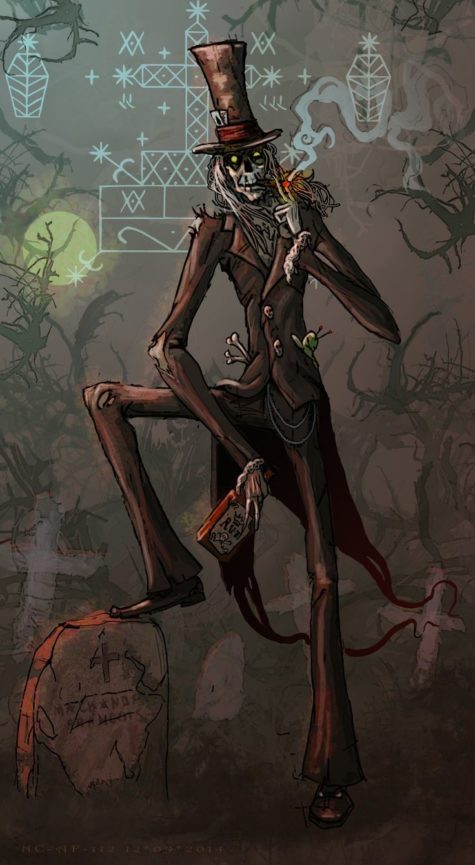 Baron Samedi manifests as an older, dark-skinned man in formal attire, dressed completely in black. He wears a black top hat, black suit, and may be smoking one of his beloved cigars. He wears impenetrable black sunglasses.
Baron Samedi manifests as an older, dark-skinned man in formal attire, dressed completely in black. He wears a black top hat, black suit, and may be smoking one of his beloved cigars. He wears impenetrable black sunglasses.
- The glasses may be missing a lens because he possesses two kinds of vision: he simultaneously sees the realms of the living and the dead.
- Alternatively his glasses have but one lens because a penis has but one eye and the phallus is his attribute (and because he loves sexual humor and innuendo.)
He is usually depicted with a top hat, black tail coat, dark glasses, and cotton plugs in the nostrils, as if to resemble a corpse dressed and prepared for burial in the Haitian style. He has a white, frequently skull-like face (or actually has a skull for a face), and speaks in a nasally voice. The former President for Life of Haiti, François Duvalier, modeled his cult of personality on Baron Samedi; he was often seen speaking in a deep nasal tone and wearing dark glasses.
- Favored People
Children; women seeking to conceive; funeral workers; grave diggers; those whose work brings them into contact with death.
Connection to other loas:
Baron Samedi is the leader of the Guédé, loa with particular links to magic, ancestor worship and death. Samedi is a loa of the dead, along with Baron’s numerous other incarnations Baron Cimetière, Baron La Croix, and Baron Kriminel. These lesser spirits, all dressed like the Baron, are all as rude and crude, but not nearly as charming as their master. They help carry the dead to the underworld.
Working with Baron Samedi
- Iconography: Baron Samedi’s throne is a chair chained to a cross. Images of Darth Vader are supposed to represent him (or just to decorate his altar; he likes toys)
- Attributes: Coffin; phallus, skull and crossbones; shovel; grave; black sunglasses; cross
As well as being master of the dead, Baron Samedi is also a giver of life. He can cure any mortal of any disease or wound, if he thinks it is worthwhile. His powers are especially great when it comes to vodou curses and black magic. Even if somebody has been afflicted by a hex that brings them to the verge of death, they will not die if the Baron refuses to dig their grave. So long as this mighty spirit keeps them out of the ground, they are safe.
He also ensures that all corpses rot in the ground to stop any soul from being brought back as a brainless zombie. What he demands in return depends on his mood. Sometimes he is content with his followers wearing black, white or purple clothes or using sacred objects; he may simply ask for a small gift of cigars, rum, black coffee, grilled peanuts, or bread. But sometimes the Baron requires a vodou ceremony to help him cross over into this world.
- Offerings
Black coffee, plain bread, dry toast, roasted peanuts. He drinks rum in which twenty-one very hot peppers have been steeped. Cigars, cigarettes, dark sun glasses, Day of the Dead toys, the sexier and more macabre the better; raise a skull and crossbones pirate flag for him, beautiful wrought-iron crosses are crafted in his honor.
- Veve
The veve or symbol for Baron Samedi is as follows:
Sources: Wikipedia and Encyclopedia of Spirits
The simplest definition of ghosts is that they are souls of the dead. Theoretically the word ghost encompasses all dead souls. However, dead souls who fade away and never reappear are memories, not ghosts. The word ghost implies that the dead soul maintains a presence in the realm of the living or perhaps refuses to leave.
Some ghosts may not realize they’re dead or may not know how to leave or where to go. In these cases, the living can intervene to help them transition via rituals, through shamans, or by requesting that a psychopomp escort the dead soul to safety.
Whether the presence of a ghost is intrinsically harmful is subject to debate. In some cultures, contact with ghosts is toxic to the living either because of mal-intent or just because contact with the dead is debilitating. Other cultures consider each ghost an individual case. Some are benevolent; some are lethal; others are just neutral presences having little effect one way or the other.
Some ghosts exhibit scary behavior, but many people find all ghosts frightening just because of their associations with death or the supernatural. No chain-clanking or nocturnal groaning is required; the ghost doesn’t actually have to do anything to cause fear other than be present.
Not all ghosts mean harm. Some simply enjoy lingering near the living. They do feed off human energy, tapping into the energy of individuals as if it were a power source: There’s a bit of a vampiric quality to this, but if not excessive it will not harm the average healthy individual. A ghost may actually be less energy-draining than some living “psychic vampires.”
Ghosts who linger without causing trouble can be tolerated. Some people enjoy the presence of ghosts. The reputed presence of ghosts is a selling point for many hotels, inns, and bed-and-breakfasts. Sensitive people can see ghosts, even if the ghosts don’t want to be seen. Put out an offering for them periodically. Make them feel welcome and this type of ghost can transform into an ally or be helpful in emergencies.
Some ghosts remain on the earthly plane because they are caught in a time warp: they constantly relive a tragedy that they experienced while alive. Some ghosts won’t leave because they have a mission. It may be to protect someone, to reveal information, or to seek revenge. Some ghosts are consumed with rage and resentment.
Raging ghosts who loathe and envy the living are dangerous ghosts. The most powerful can manifest in corporeal form and harm the living. Ghosts who are powerful enough to exert their individuality often transcend ghost status to become spirits. If honored and propitiated, even hostile ghosts can sometimes be persuaded to use their power benevolently.
Spirit mediums channel dead souls for benevolent purposes. Seances invite participation of dead souls so that they can provide information, comfort, and healing. Some dead souls, however, possess the living for their own selfish or destructive purposes. These must be exorcised or somehow made to leave.
Various spirits are renowned ghost busters. Sometimes even an image or amulet bearing their name is sufficient to send ghost packing. See the Ghost Busters page.
If a ghost can’t be exorcised, it can be distracted. Many ghosts, like low-level demons, demonstrate obsessive-compulsive behavior. Scatter tiny poppy or millet seeds. The ghost may feel compelled to pick up or count each and every one.
- Hanging up a many-holed sieve or fish net may have the same effect.
- Alternatively leave a ghost some thread and a needle with a broken eye. Some ghosts will spend eternity attempting to thread the needle, in the process, ceasing their depredations.
How someone died may effect what type of ghost they become. Allegedly those who die suddenly, violently, or before their time are more likely to become malevolent ghosts. In many parts of the world, the most feared ghost is a woman who died in childbirth. It’s crucial to point out, however, that not everyone who dies violently becomes a harmful ghost. Clearly most murder victims do not transform into rampaging supernatural beings, or there would be far less murder. It is not entirely clear why some victims of violent crimes turn into benevolent helpers while others become utterly consumed with rage and anger toward the entire world.
Various botanicals are said to discourage the presence of ghosts, especially rue and garlic. See the post on Ghost Busting with Botanicals for a more extensive list.
From: Encyclopedia of Spirits
A revenant is an animated corpse typically possessed by a spirit that was believed to return from the grave to terrorize the living. The word “revenant” is derived from the Latin word, revenans, “returning” (see also the related French verb “revenir”, meaning “to come back”).
Vivid stories of revenants arose in Western Europe (especially Great Britain, and were later carried by Anglo-Norman invaders to Ireland) during the High Middle Ages. Though later legend and folklore depicts revenants as returning for a specific purpose (e.g., revenge against the deceased’s killer), in most Medieval accounts they return to harass their surviving families and neighbors. Revenants share a number of characteristics with folkloric vampires.
Many stories were documented by English historians in the Middle Ages. William of Newburgh wrote in the 1190s,
“It would not be easy to believe that the corpses of the dead should sally (I know not by what agency) from their graves, and should wander about to the terror or destruction of the living, and again return to the tomb, which of its own accord spontaneously opened to receive them, did not frequent examples, occurring in our own times, suffice to establish this fact, to the truth of which there is abundant testimony.”
Stories of revenants were very personal, always about a specific individual who had recently died (unlike the anonymous zombie depicted in modern popular culture), and had a number of common features.
Source: Wikipedia
The dark powers emanate from the dark aspects of the Goddess and the God. This is the power of the Crone and the Lord of the Shadows; the Hag and the Hunter. The dark powers are more than just a personification of the negative influences in life, however, and the energy raised through the dark imagery of the Divine is very potent. As such, be careful what you do.
The Dark Goddess is manifested in mythology as various kinds of death crones, wise hags, devastation, war, disease and barrenness of the land. She is the Bone Mother who collects the skulls of the dead for the ossuary. In Irish mythology, Morrigan and Nemain would be considered Dark Goddesses in that they are associated with War and Death.
The Dark God is seen in mythology as the silent host to the dead in his underground realm of gray shadows and deep sleep, knowing of secrets and wise of the universe, death, war, destruction, gatherer of souls and harbinger of chaos. He is the Hunter, whose wild hunt, or raid, ingathers the energies of the soul.
There is sense to this ancient cosmology. Cults of ancient times focused on the dark aspects of the Divine so that their followers would move past their fear of mortality to seize upon the recognition of their eternal immortality.
In Irish mythology, Crom Cruach, and Donn would be considered “Dark Gods” or “Dark Powers” because Donn was the god of the dead Milsians. At death, Mannannan Mac Lyr carried the soul to Tech Dunn or the House of Donn. In texts like the Dinsenchus there is references to Crom being considered to be a dark god, contrasting a light god, in a way that is very similar to the Slavic god Czernobog.
As a power, the Dark Lord is the Chaos from which Order must evolve. Yet there is no ending to this cycle, Order resolves again as Chaos to be reborn as New Order. The Lord of Shadows as Death becomes the process of new life by gathering the energy of dying life, and the Passage into a new material form is through the Crone.
In the aspect of light, the god dies willingly by entering the ground to bring his vitality to crops that will be harvested to feed humanity. Through this selfless act, he revitalises the earth. He does this through the Crone. The marriage of Lugh in August, celebrated as Lughnasadh, is the start of the descent into Mother Earth. Once there, he is transformed into the son within the goddess. Hence, the pagan god is both Father and Son, which is yet another concept that Christianity absorbed from the pagans. The harvest comes, the seasons change, and the Mother becomes the Crone of Autumn and Winter, only to be transformed into Mother again at Winter Solstice with the rebirth of the Sun (her son, the god). See Also: Cernunnos, Green Man and Herne.
The womb-tomb is the domain of the Crone and is a place of great power. This is where the transformation takes place, with energies of death given repose and returned to form as the energies of life. When this power is confronted and recognised, there comes a freedom from fear, a new sense of independence and a recognition of personal responsibility. We are not judged in Death by the Lady and the Lord, but we are Self-judged. From the quietude of the realm, we move through her into new life. That is the balanced, pagan theme of the cauldron, the god of self-sacrifice and the resurrecting goddess. It is this power of the goddess that significantly differentiates the old and new religions.
Thus, in an historical sense, while the Dark Lord guides the chaos of social and cultural changes through the Crone into a new life, the Crone becomes not the terror of death, but the joyful passage to new vibrant societies through the death of the outmoded and stagnant ones. She is Fata Morgana, the Huntress Diana, Minerva, Cerridwen, Sati and Kali. He is Pluto, Hades, Cerunnos, Herne the Hunter, Set and Shiva. But the names may not convey the image needed by the practitioner unless you are able to move beyond the modern association of darkness as evil.
By accepting that the dark powers are in balance with the light powers, you are able to utilise the wholeness of the Power. The dichotomy of good and evil do not apply to what simply is. Energy can be drawn to the light or to the dark; thus death provides the soul’s passage to whichever realm the soul-energy has been drawn. Energy is always in motion, and flows back and forth between light and dark. What at one time is light energy turns and becomes dark energy. Through the practice of the Craft, the witch directs this energy for beneficial purpose. To do otherwise, is to inflict Self-harm.
To face the Underworld and the power of the dark aspect of the Divine is to understand that dark is part of the necessary blend of light and not something to fear. The unifying of the dark and the light within the individual offers wholeness and peace, which may then be transferred to external contacts.
From: Green Witchcraft II
In Slavic folklore, Baba Yaga is a supernatural being (or one of a trio of sisters of the same name) who appears as a deformed and/or ferocious-looking woman. Baba Yaga flies around in a mortar, wields a pestle, and dwells deep in the forest in a hut usually described as standing on chicken legs (or sometimes a single chicken leg).
Baba Yaga may help or hinder those that encounter or seek her out. She offers comprehension, not comfort. She sometimes plays a maternal role, and also has associations with forest wildlife. She is a many-faceted figure, capable of inspiring those who seek to see her as a Cloud, Moon, Death, Winter, Snake, Bird, Pelican or Earth Goddess.
Baba Yaga is an enigmatic spirit who rules the conjunction of magic and harsh reality, of limits and possibilities. This Death Spirit provides fertility when she chooses, but she also consumes those who disappoint her. She is iron-toothed, boney-legged, and wears a necklace of human skulls. Her home is surrounded by a fence crafted from human bones and, when inside of her dwelling, she may be found stretched out over the stove, reaching from one corner of the hut to another.
Like her compatriot spirits, Kali and La Santisima Muerte, Baba Yaga encompasses all the mysteries of life and death; contemplate her in order to begin to comprehend these mysteries. I don’t suggest contacting her (the Baba has little patience; don’t waste her time without good reason), a kind of magical contemplation is recommended instead.
Connecting With Baba Yaga
The Baba Yaga’s Feast Day is usually celebrated on the first full moon in November, but a connection can be made at any time during the year.
- Build an altar featuring birch wood and leaves, animal imagery, a mortar, pestle and broom, and especially, food and drink.
- Baba Yaga is always voraciously hungry. Offer her real food or cut out photo images for the altar. She is especially fond of Russian extravagances like coulibiac.
- Offer her a samovar with blocks of fine Russian caravan tea and perhaps a water pipe.
- Sit with the altar, gaze at it from different angles, play with the objects and see what comes to mind.
Be patient, and expect that it will take time to achieve a connection and a response.
More About Baba Yaga
The ‘old woman’ of autumn was called Baba by the Slavic inhabitants of eastern Europe, Boba by the Lithuanians. This seasonal divinity lived in the last sheaf of grain harvested in a year, and the woman who bound it would bear a child that year. Baba passed into Russian folk legend as the awesome Baba Yaga, a witchlike woman who rowed through the air in a mortar, using a pestle for Her oar, sweeping the traces of Her flight from the air with a broom.
A prototype of the fairytale witch, Baba Yaga lived deep in the forest and scared passersby to death just by appearing to them. She then devoured Her victims, which is why Her picket fence was topped with skulls. Behind this fierce legend looms the figure of the ancient birth-and-death Goddess, one whose autumn death in the cornfield led to a new birth in spring.
Baba Yaga is a Slavic version of Kali, the Hindu Goddess of Death, the Dancer on Gravestones. Although, more often than not, we consider Baba Yaga as a symbol of death, She is a representation of the Crone in the Triple Goddess symbolism. She is the Death that leads to Rebirth. It is curious that some Slavic fairy tales show Baba Yaga living in Her hut with Her two other sisters, also Baba Yagas. In this sense, Baba Yaga becomes full Triple Goddess, representing Virgin, Mother, and the Crone.
Baba Yaga is also sometimes described as a guardian of the Water of Life and Death. When one is killed by sword or by fire, when sprinkled with the Water of Death, all wounds heal, and after that, when the corpse is sprinkled with the Water of Life, it is reborn. The symbolism of oven in the Baba Yaga fairy tales is very powerful since from primordial times the oven has been a representation of womb and of baked bread. The womb, of course, is a symbol of life and birth, and the baked bread is a very powerful the image of earth, a place where one’s body is buried to be reborn again.
It is interesting that Baba Yaga invites Her guests to clean up and eat before eating them, as though preparing them for their final journey, for entering the death, which will result in a new clean rebirth. Baba Yaga also gives Her prey a choice when She asks them to sit on Her spatula to be placed inside the oven: if one is strong or witty, he or she escapes the fires of the oven, for weak or dim-witted ones, the road to death becomes clear.”
Baba Yaga lives in the middle of a very deep forest, in a place which is often difficult to find unless a magic clue (a ball of yarn or thread) or a magic feather shows the way. The old hag lives in a wooden hut on two chicken legs (sometimes three or four legs are described).
Usually the hut is turned with its back towards a traveler, and only magical words can make it turn around on its chicken legs to face the newcomer. Very often, the hut revolves with loud noises and painful screams that make a visitor cringe. This serves to frighten the reader, showing the hut’s old age, and to show that Baba Yaga does not care about her hut’s well being.
- Baba Yaga fairy tales can be found at Widdershins.
It is also fascinating that some fairy tales describe the hut as being a unique evil entity: firstly, it has the ability to move on its chicken legs. Secondly, it understands human language and is able to decide whether and when to let a visitor enter its premises. Finally, the hut is often depicted as being able ‘to see’ with its eyes (its windows) and ‘to speak’ with its mouth (its doorway). I also cannot help feeling that the hut is able ‘to think’, and one can observe these thoughts as wild powerful clouds of steam emerging from the hut’s chimney. What powerful imagery!
Baba Yaga’s hut is often surrounded by fence made of human bones and topped with human skulls with eyes. Instead of wooden poles onto which the gates are hung, human legs are used; instead of bolts, human hands are put in; instead of the keyhole, a mouth with sharp teeth is mounted. Very often Baba Yaga has her hut is protected by hungry dogs or is being watched over by evil geese-swans or is being guarded by a black cat. The gates of Baba Yaga’s villa are also often found to be guardians of Yaga’s hut as they either lock out or lock in the Witch’s prey.
Baba Yaga – The Black Goddess – An Essay
For those of you who enjoy a more scholarly approach to the goddess, here is an essay by an anonymous author about Baba Yaga, the Black Goddess, and what her mythology represents.
Baba Yaga and her Magical Colts
I have been thinking and thinking about the image and story of Baba Yaga now for months and wondering how girls and women can resolve the seemingly paradoxical story of a bony heartless witch with the image of innocence of a rejected and abandoned girl. The following essay outlines how we use myth and story to perpetuate unconscious mindsets and it also unveils the gifts that these stories unfold in our inner psyche.
The story of Baba Yaga is prime among many images of the Black Goddess. The Black Goddess is at the heart of all creative processes and cannot be so easily viewed. Men and women rarely approach her, except in fear. Women are learning of her through the strength and boldness of elder women who are not afraid to unveil her many faces.
Sofia as wisdom lies waiting to be discovered within the Black Goddess who is her mirror image. Knowing that, until we make that important recognition, we are going to have to face the hidden and rejected images of ourselves again and again.
As women, we are confronted throughout our lives with unavoidable body messages regarding the uniqueness of our form and the inevitable changes that characterize aging and the passage of time. Although aging presents difficult challenges for both men and women, women confront some specific difficulties because of their gender. In traditional narratives, the end of biological fertility has relegated women to the status of “old women” who are stereotypically viewed as poor, powerless, and pitiful in our sexist and youth oriented culture. Baba Yaga, often referred to as the Black Goddess, and Vasalisa, often representing Sophia, are intrinsic to the psyche of girls and women because they shows us that the illusion of form can hide wonderful qualities within.
Baba Yaga, ugly, haglike, flying in her mortar,
seemingly isolated and abandoned,
yet broom at hand, ready to sweep the clouds across the skies
and reveal her hidden cosmic nature
One of the cruelest of stereotypes that older women face is the “menopausal woman.” These are accentuated by the very fact that younger women are often rejecting or distancing to older women in society, unwilling to identify with women older than themselves. These experiences are painful confirmations that the aging woman no longer meets the social criteria of a physically and securely attractive woman. The common result for most women is the activation of shame — as if becoming/looking older means that something is deeply and truly wrong with oneself.
Conscious femininity is a cyclic process and involves an awakened awareness of the triple form of the Goddess – Mother, Virgin and Crone – and how she exists simultaneously and continuously in all of our psyches, each taking center stage in awareness at different moments. These archetypal patterns are considered intrapsychic modes of consciousness in the individual, and the primordial image of a powerful and integrated woman, crowned with wisdom gleaned through real experience, is again reemerging through both the individual and collective psyches of humanity.
First, however, women must learn to embrace, respect and honor their changing bodies, abilities, capacities and WISDOM. We can learn a lot from Baba Yaga!
An archetype is a universal symbol, an inherited mental image to which humankind responds, and which is often acted upon as an unconscious reaction to human experience. These stories are no different and the story of Baba Yaga exemplify this phenomena.
The female experience is symbolized by and archetypally corresponds with the ancient Triple Goddess as the creator and destroyer of all life — “the ancient and venerable female divinity embodying the whole of female experience as Virgin, Mother, Crone.” The archetypal figure representing the end of a woman’s childbearing years, or the “third age” for women, is the third aspect of the Triple Goddess, the Crone.
At the climacteric or menopause, women are often forced to stand precipitously between the culmination of past experiences, to realize that youth is left behind, and prepare a new space within whereby a fresh image will coalesce as she envisions her future. This is real labor. The traditional constructs that are available to women are largely influenced by patriarchal standards of youth and beauty and we need fresh constructs that honor the diversity of life in all of its forms.
When a culture’s language has no word to connote “wise elder woman,” what happens to the women who carry the “Grandmother” consciousness for the collective? Prejudicial (prejudged) attacks throughout history against older women symbolized patriarchy’s feminization of fear: the ultimate fear of annihilation, to be nonexistent (no existence). Centuries-long indoctrination limits our imagination so that we see this ancient aspect of the feminine only in her negative forms. We see her as the one who brings death to our old way of being, to our lives as we have known them, and to our embodied selves.
Our fear of the unconscious makes the Crone or Baba into an image of evil. The prevalence of paranoid masochism finds its expression through feminine perversion. Kristeva writes from “Stabat Matar” that: “Feminine perversion is coiled up in the desire for law as desire for reproduction and continuity, it promotes feminine masochism to the rank of structure stabilizer.” Structure stabilizer! Natural death is to be feared, hidden away, certainly not recognized as part of the natural rhythm of cycles of birth, death and rebirth?
Only when death becomes projected does it become a monster to be feared. There is an unconscious belief that a woman who has outlived her husband has somehow used up his life force. Walker claims that the secret hidden in the depths of men’s minds is that images of women are often identified with death. Women have also bought into this mindset largely because of lost connection with their own spirituality and the natural cycles of nature!
Vasalisa Approaching the Hut of Baba Yaga
To be sent to Baba Yaga was tantamount to being sent to one’s death, but Vasalisa was actually helped by Baba Yaga. By facing her own worst fear — death itself, Vasalisa became liberated from her previous situation and immaturity.
The myths of our society tell us much about the attitudes and world view of the myth-owners, and these attitudes are the products of women’s roles within the wider society. Myth arises out of the collective level of humankind’s experience, which is presented through images and symbols that resonate within our psyche. It is something we inherit from our ancestors and it is expressed through our genetic, racial memory. Kaufert reminds us however, that “myth is a system of values presented as if it were a system of facts.”
The symbol of the Crone is unique to a feminine worldview where the face of the Virgin and the fecund Mother, the Virgin Mother Mary, was absorbed in Western tradition into Judeo-Christian imagery. Likewise, we see the image of Vasalisa embodied as this innocence. The Crone has retained much of her pre-patriarchial character where she has haunted the fringes of Western culture, largely ignored, unacknowledged and rejected; one that often strikes fear into the hearts of men and some women because she has tremendous power and cannot be confined.
“Wise women,” in the past, were literally seen as having the power of life and death. They symbolized maturity, authority, attuned to nature and instinct. They were women whom men could not bind by making pregnant. They personified, as Hall writes:
“That aspect of life that men would most like to control but against which they are powerless: death. The Crone was healer, seer, medicine woman and, when death arrived with inexorable certainty, she was the mid-wife for the transition to another life.”
Baba Yaga’s Hut standing on its magical Chicken-Leg,
yet revolving like the solar symbol it is,
always rising and setting in a new place,
bringing birth — and death — daily.
Over time, and in recent history the Crone became associated with the dark side of the feminine; the withered old hag, the witch. Ironically, the word “Hag” used to mean “holy one” from the Greek hadia, as in hagiolatry, “worship of saints.” And during the middle ages hag was said to mean the same as fairy.
In deconstructing these familiar images of the older aging woman, we must first identify their symbolic roots and challenge them in order to allow for potent, vital images that energize women’s potential creative spiritual evolution. In this quest it is crucial to find valued female images that present creative and spiritual power, that offer a paradigm of ongoing formation and integration. If we do not do so, we risk encountering images of women that reinforce stereotypical models and moreover, can only alienate us from our own truest selves.
The Crone is a figure who incorporates both dark and light, life and death, creation and destruction, form and dissolution. The doll [Vasalisa’s doll, given to her by her dying mother] becomes the symbol of the Sibyl, a figure of inspiration and intuition. She acts as a guide through the great passages of life, leading a woman into her own inner knowing.
Vasalisa and her doll with the White Horseman of Dawn(who reports daily to Baba Yaga, just like the Red Horseman of Noon, and the Black Horseman of Evening)
We see this in the story of Vasalisa and Baba Yaga, the innocence of the maiden coming of age through a series of tasks. Baba Yaga forces Vasalisa to look within through intuition (the doll) and she awakens to the illuminating light that is carried in her heart. Within the simple limits of a folk story, the interactions of Sophia (Vasalisa) and the Black Goddess (Baba Yaga) are demonstrated. Baba Yaga or the Crone also embodies the inner archetype of Sophia, feminine wisdom.
Hall writes: “Sophia is a Wise Woman, one who epitomizes feminine thought. This thought is of a particular kind. It is ‘gestalt’ or whole perception; it synthesizes and looks at the overall pattern; it is logical but empathetic, and combines acute observation with intuition. It is relational (taking account of the past in order to project forward into the future), and it arises out of care and concern for man and womankind. It uses both the left and right brain modes of thought. It is creative and concerned with vision and solutions — attributes which are an integral part of the Wise Woman.”
Sophia plays, hides, adepts, disguises, and brings justice. Interestingly, we see these very same qualities attributed to the wise woman as being Vasalisa’s, only not fully formed. Thus affirming the feminist perspective of the Goddess in all of her aspects and that all ways to wisdom are valid paths. Girls and women are encouraged to rely on their own subjective experience or on the communal experience of other women This is a very important point!
From a feminist perspective, the entry into the third phase of women’s life is seen as a time of spiritual questing, renewal and self-development. It is a time where women are encouraged to explore themselves through interaction with other females who are providers of friendship, support, love, even sexual satisfaction, rather than a woman’s family.
Baba Yaga helping young Ivanushka
Likewise, the young girl growing into maidenhood needs the guidance and wisdom that elder women can provide. She must receive the gifts that the wise ones can give her. Baba Yaga may appear as a witch, yet she is instrumental in folk traditions. She aids heroes to find weapons, simplifying tasks and quests when she is treated with courtesy. Her transposed reflection is none other than Vasilisa the fair – the young righteous maiden who defeats her opposite aspect by truth and integrity.
The older woman is the keeper of the wisdom and tradition in her family, clan, tribe, and community. She is the keeper of relations, whether they be interpersonal or with all of nature. Every issue is an issue of relationship. It is assumed that she has a deep understanding of the two great mysteries, birth and death.
Another quality is the ability to be mediator between the world of spirit and earth. She is emancipated from traditional female roles of mothering and is free to make a commitment to the greater community. As a result of this freedom, there is an abundance of creativity unleashed in this phase of life; often expressed through art, poetry, song, dance, and crafts, and through her sexuality as she celebrates her joy (Joussance).
This elder time must again become a stage of life revered and honored by others and used powerfully in service by women themselves. The elder “Wise-woman” can represent precisely the kind of power women so desperately need today, and do not have: the power to force the hand of the ruling elite to do what is right, for the benefit of future generations and of the earth itself.
A powerful Baba Yaga, flying in her mortar,
protecting her forests, and banishing all obstacles with her pestle and broom.
Like Baba Yaga, the Crone must help us by her example and “admonish us to revere all peoples and all circles of life upon this earth . . . not only important for the dignity and self-esteem of each woman, but vital for the countenance of life on our sweet Mother Earth.” Since men define power as the capacity to destroy, the Destroying Mother Crone must be the most powerful female image for them, therefore, the only one likely to force them (us) in any new direction.
A woman who denies her life process at any time in her development, clinging desperately to outmoded images, myths and rituals of her past, obscures her connection with Self, the Divine, and therefore, with her spiritual heritage, the natural universe. The same holds true for our daughters, maidens who are coming of age. There is a kind of internal balance and sense of holiness available to us when we accept ourselves as part of a world that honors cycles, changes, decay and rebirth. It is time for women to reflect and give form to the authentic self in its evolving, formative process.
The woman who is willing to make that change must become pregnant with herself, at last. She must bear herself, her third self, her old age with labor. There are not many who will help her with that birth. To Crone is to birth oneself as “Wise-woman,” and see the world through new eyes.
We have not had the safety valve of feminine metaphor in our spiritual understanding; consequently, the Feminine, both Divine and human, have appeared monstrously contorted, threatening and uncontrollable.
The Black Goddess lies at the basis of Spiritual knowing, which is why her image continuously appears within many traditions as the Veiled Goddess, the Black Virgin, the Outcast Daughter, the Wailing Widow, the Dark Woman of Knowledge.
The way of Sophia is the way of personal experience. It takes us into the realm of “magical reality,” those areas of our lives where extraordinary vocational and creative skills are called upon to manifest. Those treasures of Baba Yaga and Vasalisa lie deep within each of us, waiting to be discovered.
Baba Yaga and Vasalisa,
Crone and Puella [Maiden]: Two Aspects of One Archetype
Sources:
